** Updated with recently released CWGC records and photos, October 2014, February 2015 and July 2022**
If I had the chance to name a rose, one of my choices would be “Walter Henry Morland“. The reason?
For a war where flowers have become so symbolic from Flanders or Somme poppies to the Roses Of Picardy, it is not surprising to find the answer in a garden.
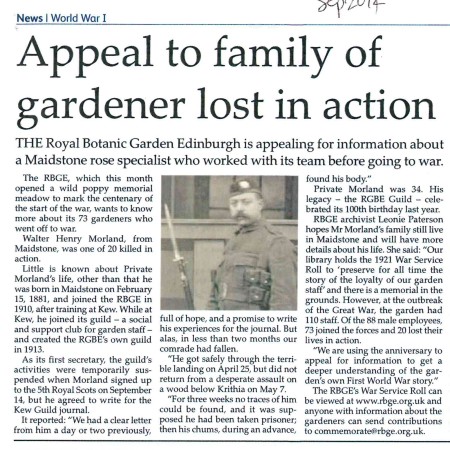
Royal Botanic Gardens Edinburgh search for Walter Morland’s relatives, Maidstone Downs Mail September 2014
Tucked away in a corner of Kew Gardens inside the Temple of Arethusa is the war memorial of the Royal Botanic Gardens Kew. On it are listed 37 names of the Kew Gardens staff and also of Old Kewites who died on active service in the 1914-18 war including Walter Henry Morland.To misquote Rupert Brooke’s The Soldier poem of that war, there are many a “corner of a foreign field that is forever England” (and Scotland, Canada …)
A stylised poppy forms the new logo for the First World War Centenary events at www.1914.org
Recently all the surviving issues of the Kew Guild Journal since 1893 have been scanned and made available free online, so that people can trace the exploits of Old Kewites, as past staff and students are known wherever they may be in the world.
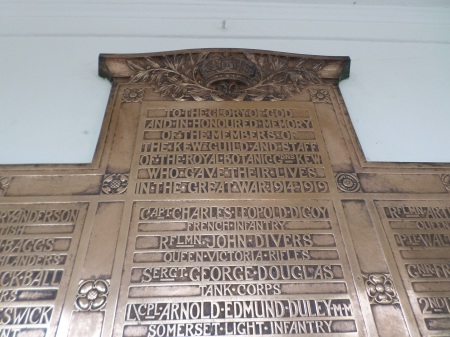
WW1 Header section, Kew Gardens staff war memorial Royal Botanic Gardens Kew (Image source: Mark Norris, World War Zoo gardens project, Newquay Zoo)
Kew have recently blogposted about their war memorial as part of their Ww1 exhibition.
I came across the Kew Guild Journal online whilst researching the effects of wartime on zoos and their associated botanic gardens. Using the ‘additional information’ keyword search function (botanist, gardener etc) on the Commonwealth War Graves Commission website, I came across Private Walter Henry Morland, “on staff at Royal Botanic Gardens Edinburgh as a Rose Specialist” his CWGC listing said. This small detail may have been chosen by his widow Annie or grieving parents. This soon led to me finding a link to the basic list of names on Rootschat of the 37 Kew staff lost in the Great War.
Looking at this list as part of the World War Zoo Gardens project is an interesting parallel to the few war memorials to zoo staff such as London Zoo that I have uncovered and posted about, investigating how the war affected different zoos and other related institutions. There is an equally interesting list on the memorial at the Natural History Museum in London, which I will blog post about in future.
Some botanic gardens like Birmingham added a zoological collection to enhance their interest and finances. Ray Desmond the Kew historian calls this the ‘Zoological procilivities’ of many botanic gardens.
Kew Gardens had its own exotic animal collection in Edwardian times, mainly exotic birds such as storks in 1890, apparently first breeding in this country at Kew in 1902. The first pelican was presented to Kew in 1896, the same year as the first women gardeners who would expand in numbers during the First World War. Penguins were presented by former Kew staff from the Falklands in 1899. Two pairs of grey squirrels were presented as exotic rarities (later to be regretted) by the Duke of Bedford, patron of London Zoo.
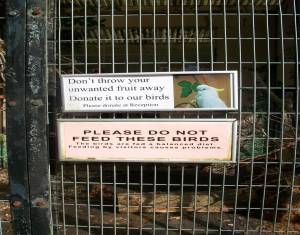
The “Zoological proclivities” that Ray Desmond notes of the animal collections at Kew and other Botanic Gardens in Victorian and Edwardian times survive still at Birmingham Botanic Gardens in their old and new aviaries (sign photographed by Mark Norris, 2011)
I’ve previously posted about Birmingham Botanic Gardens which survived both wars with its plant and animal collections intact. The exotic birds are still there. You can trace through the individually scanned articles in the Kew Guild Journal online the movements of former staff like Private Albert Wright who moved to Kew from Birmingham Botanic Gardens in May 1912 as Assistant 1st Class and returned there to Birmingham by 1915. Private Albert Wright is the last named of Kew’s casualties on the memorial and one of the last to die from his war injuries, on 25 February 1919.
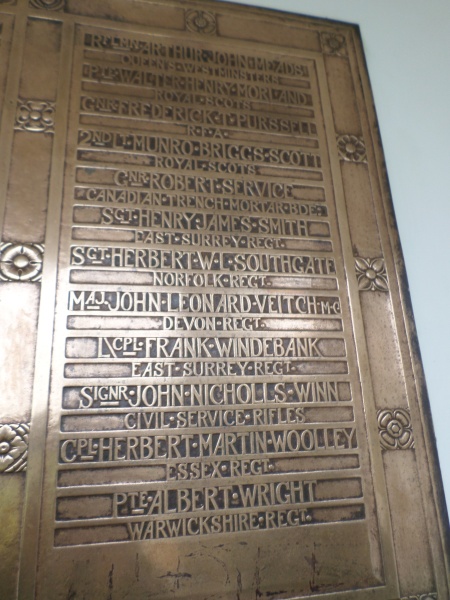
Albert Wright of Birmingham and Kew Botanic Gardens Remembered on the WW1 section Kew Gardens staff memorial (Image Source: Mark Norris, World War Zoo gardens project, Newquay Zoo)
War affected the staff and families of Kew very quickly, the director David Prain losing his only son Theodore, a 26 year old lieutenant in the Leicestershire Regiment in action on 21 October 1914.
The bronze memorial plaque inside the Temple of Arethusa was erected at Kew on 25 May 1921, designed by Sir Robert Lorimer, a noted Scottish architect who designed several other war memorials. There is a good photograph of the plaque and temple building on the Geograph website by David Hawgood.
The 37 names are recorded in the 4th issue for 1921 of the Bulletin of Miscellaneous Information (Royal Gardens, Kew) which mentions:
“some of whom left Kew direct to join the Forces, whilst others returned home from abroad or joined up in their adopted countries … The men belonged to all ranks from the scientific to the labourer staff, but the percentage of the advanced Student Gardener is singularly heavy. Of this class, ten were Subforemen; all joined the Colours but five only lived to return.”
I hope this enriched list that follows (developed from the first list by helpful Rootschatters) is a useful first step for researchers and family historians. I will continue to add further details as available. Best of all, it should encourage you to visit the riches of the Kew Guild Journal online.
” The chief object of the Guild is to ‘ watch ‘ and record the careers of its members.” W. J. Bean.
Lawrence Binyon’s poem For The Fallen , familiar from many Remembrance services (and written on North Cornish cliffs not far from where I work), reminds us appropriately for gardeners working hard outdoors by the rhythm of daylight and season: “At the going down of the sun and in the morning / we shall remember them…”
Appropriately for gardeners, I have included photographs of each casualty’s cemetery gardens from the Commonwealth War Graves Commission website to show the range of landscape and planting chosen for each locality. Kew Gardens staff helped advise the Imperial (later Commonwealth) War Graves Commission on suitable planting and other Kew staff worked as Grave Registration Unit (GRU) Officers to record and organise the growing number of burials and cemeteries as the war went on.
Whilst news is given in the Kew Guild Journal about some other European members of the Kew Guild, little is recorded of the past German and Austrian gardeners who trained at Kew until after the First World War when a note of reconciliation is attempted in some obituary notices.
Royal Botanic Gardens Kew wartime casualties 1914-1919
1. Charles Henry Anderson, Albert Medal, 29 November 1916
Lance (or Lance Corporal) Charles Henry Anderson died on 29/11/1916 aged 26, Service no. 2326, 1st/14th Bn. London Regiment (London Scottish). His medal record card states that in addition to the standard Victory and British war medals, he was also awarded the Albert Medal (citation below). Anderson is buried amongst 253 WW1 Commonwealth soldier burials at Grave Reference II. K. 3, St. Venant Communal Cemetery in France. From 1915 to 1917 this cemetery was linked to British and Indian forces Casualty Clearing Stations in the area. In the Kew Guild Journal staff records he is listed around 1914/15 as a ‘Present Kewite’ (still employed actually at Kew) as a ‘Gardener’.
Additional Information on the CWGC website mentions that he was the “Son of Charles and Lizzie Anderson, of The Nest, North Stoke, Oxon.” This snippet of information is enough to start tapping into extensive family trees and other genealogical information on websites like ancestry.co.uk. Like his father Charles (b. 1856), Charles Henry was born in North Stoke, Oxfordshire. His mother Lizzie Bradshaw was born in Bensington, Oxfordshire in 1868. Anderson’s father was listed as a (domestic) Gardener on the 1891 census, so clearly something of family trade, his father later by 1916 being listed as a bailiff at Spinnys, North Stoke. His 1917 Kew Guild Journal obituary lists him as born on North Stoke on 19 October 1890.
His mother Mrs L. Anderson chose the inscription on his headstone: “I Will Give Unto Every One of You According to His Works” (Revelation 2.23)
Family research reveals that Charles left several surviving sisters to mourn his loss and those of many young men of his generation. Florence M. Anderson (born 18 Dec 1886, died 1971, Oxford) was a domestic sewing maid / servant at 25 Palace Gate, Kensington (1911 census) and married a William J Fulbrook. His other sisters and brothers were Dora Mary (b. 1895), Bertie George Glover (b. ?), Lily Olive (b. 1893), Lizzie Anderson (b.1888, died 1946, Swindon) who appropriately married a Mr. Gardner.
The citation for his Albert Medal reads: Extract from “The London Gazette,” No. 30156, dated 29th June, 1917, –
” The King has been graciously pleased to award the Decoration of the Albert Medal of the First Class in recognition of the gallantry of Lce. Cpl. Charles Henry Anderson, late of the 1st/14th Bn. of the London Regt., who lost his life in France in November last in saving the lives of others. On the 28th Nov., 1916, Lce. Cpl. Anderson was in a hut in France with eleven other men when, accidentally, the safety pin was withdrawn from a bomb.
In the semi-darkness he shouted a warning to the men, rushed to the door, and endeavoured to open it so as to throw the bomb into a field. Failing to do this, when he judged that the five seconds during which the fuse was timed to burn had elapsed, he held the bomb as close to his body as possible with both hands in order to screen the other men in the hut. Anderson himself and one other man were mortally wounded by the explosion, and five men were injured. The remaining five escaped unhurt. Anderson sacrificed his life to save his comrades.”
In research for our joint article in the Kew Guild Journal 2015, Kew and the First World War – 100 years on by James Wearn and Mark Norris, James discovered that:
This feat was remarkable, even in wartime, and was reported as far afield as Singapore. Quite unceremoniously, his death was recorded in Kew’s ledger (Men on Active Service volume, p.6) as ‘accidental death’ rather than heroism! He was posthumously awarded the Albert Medal 1st Class for a grand act of heroism and selflessness in war.
2. Arthur Edwin Baggs, 1st March 1917
Private Arthur Edwin Baggs, service number 129662, 72nd Battalion Canadian Infantry (Canadian Seaforth Highlanders), died on 1st March 1917, aged 28. He is recorded on the Vimy Memorial to the 60,000 Canadians who died in the First World War. Baggs appears to be one of 11,000 Canadians who have no known grave. Many of them died in the fight for Vimy Ridge during the Battle of Arras the month after Baggs died. Arthur was the son of Edwin and Louisa Mary Baggs, of 3605, Knight Road, Vancouver, British Columbia, Canada. He entered Kew in 1909. Listed as an Old Kewite on active service, Baggs returned to Canada when he left Kew in April 1911.
3. Charles Frederick Ball, 13 September 1915
Private Charles Frederick Ball, service number 16445, 7th Battalion, Royal Dublin Fusiliers (Pals Battalion), died on 13/09/1915, aged 36.

C.F. Ball, Dublin Fusiliers, killed at Gallipolli, pictured in The Garden obituary, October 16 1915.
“A delightful companion, unassuming, sincere and a most lovable man…” quoted from a short and touching obituary and portrait was also published in The Garden (October 16, 1915, p.514) by his friend and fellow soldier , the editor Herbert Cowley (who had been invalided out of the army).
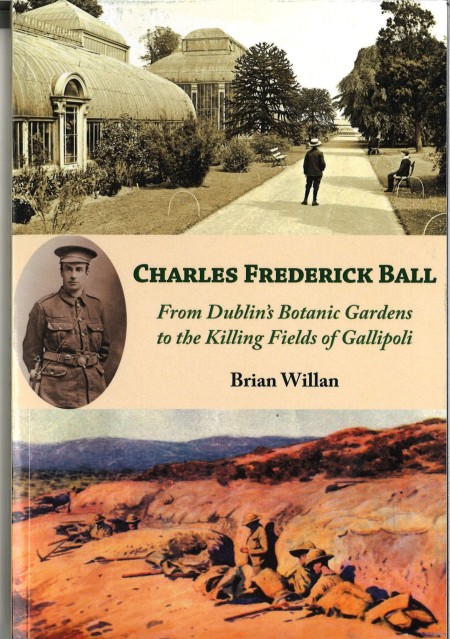
A full biography of C.F. (‘Fred’) Ball has now been published in 2022 by Brian Willan https://worldwarzoogardener1939.wordpress.com/2022/07/14/charles-frederick-ball-new-biography-by-brian-willan-kew-gardens-glasnevin-dublin-and-gallipoli-ww1/
Ball is buried at Grave Reference II. A. 8, Lala Baba Cemetery, Turkey. This cemetery was created from smaller burial grounds after the Armistice on a low hill between the southern side of Suvla Bay and a salt lake. The hill was taken in the fierce fighting of August 1915 during the Gallipolli campaign against the Turks, a doomed amphibious landing which was the brainchild of Winston Churchill.
Charles was the son of the late Alfred and Mary Ball, of Loughborough and husband of Alice A. Ball, of 15, Percy Place, Dublin, whom he married in Dublin on December 16, 1914. This was one of many such wartime marriages mentioned in the Wedding Bells section of the Kew Guild Journal. Ball had left Kew in August 1903 to work as Assistant and later Foreman at the Royal Botanic Gardens Glasnevin in Dublin. He was also editor of Irish Gardening and a friend and fellow travelling companion to Bulgaria with Kew collegue and Alpine plant enthusiast Herbert Cowley, injured in the First World World War (see previous Blog post on Cowley).
His wife Alice chose the Biblical inscription on his headstone: “Greater Love Has no Man than This”.
A Life Member of the Kew Guild, there is a lengthy tribute to Charles Ball in the Kew Guild Journal including a final sighting of him just before he died, sheltering behind a rock under fire, digging away at ‘weeds’ with his bayonet to send back home seeds to his botanic garden colleagues. From the tone of the account, this seemingly strange behaviour had happened several times! His obituary notes that:
” Even while on active service in Gallipoli his love of collecting persisted, and numerous seedlings are
growing on at Glasnevin from seeds he sent home, gathered in the vicinity of Suvla Bay.”
Oak seeds were sent back by a Kew officer from Gallipoli for cultivation at Kew (see W.H. Morland’s entry). Later entries in the Kew Guild Journal 1921 are from Old Kewites who had travelled across this area, noting as botanists and gardeners would, what native plants were found there, soil types and climate along with the planting by the then Imperial War Graves Commission (now CWGC). Kew staff and Old Kewites were involved for many years as horticultural advisors to the Commission.
A cultivar of the South American shrub Escallonia is named ‘C.F. Ball’ in his memory, a beautiful shrub with dark green leaves and bright red flowers, excellent for bees. It is available from many nurseries.
This is pictured along with his medal; cards on the Flower of the Dublin Fusiliers message board.
4. John Charles Beswick, 22 or 28 April 1917.
2nd Lt. John Charles Beswick, 11th battalion, Royal Lancaster Regiment (Kings Own) died 22 April 1917. He is buried in plot VII.A.2 at Cambrai East Military Cemetery, Northern France.
Cambrai was in German hands for much of the war and Plot VII contains the graves of Commonwealth prisoners, relecting the fact that Beswick died as a prisoner of war. His Kew Guild Journal 1918 obituary lists his death of wounds in a German Field Hospital at Cambrai on April 28, 1917. Not far away, fellow Kewite George Douglas is remembered on another Cambrai memorial to those with no known grave.
Born on 5 October 1888, Beswick was on the Kew staff in 1913, having entered Kew as a sub-foreman in the Temperate House, Kew, September 1912. He enlisted in 1915, joining the Royal Army Medical Corps, then transferring to the Artists Rifles with whom he embarked for France. He was given his officer commission into the Royal Lancaster Regiment.
He was previously at Fota Island, Queenstown in Ireland, where his father William Beswick was Head Gardener to Lord Barrymore. I last visited Fota about 15 years ago to see Fota Wildlife Park at Cork in Ireland. This is alongside the arboretum and the gardens where Beswick worked. The gardens then felt a little neglected, but the grounds showed a glimpse of past splendour. I ate almost rottingly ripe windfall medlars for the first time in what must have been an orchard or productive gardens. It is now run by the Office of Public Works whilst the old Fota House of the Smith-Barry family has recently been renovated by the Irish Heritage Trust and is open to the public (www.fotahouse.com).
A book on Fota’s restored gardens and their history has recently been published. According to an article in The Irish Examiner paper website:http://www.irishexaminer.com/lifestyle/features/profiles/the-secret-gardens-195831.html
“[Charlie Beswick] studied botany in Kew Gardens in London before enlisting with the King’s Own Lancashire Regiment, his two older brothers, William Jr and Arthur, already in service. Among the letters home from the front is the last one Charlie sent as he was about to lead his platoon into action. ‘With God’s help [I] shall return safely,’ he wrote, in a more hurried version of the script of his childhood schoolbooks. ‘… if not, I shall do my duty to the best of my ability.’ Trying to drag a wounded comrade to safety, he was shot and died in a German field hospital in 1917.”
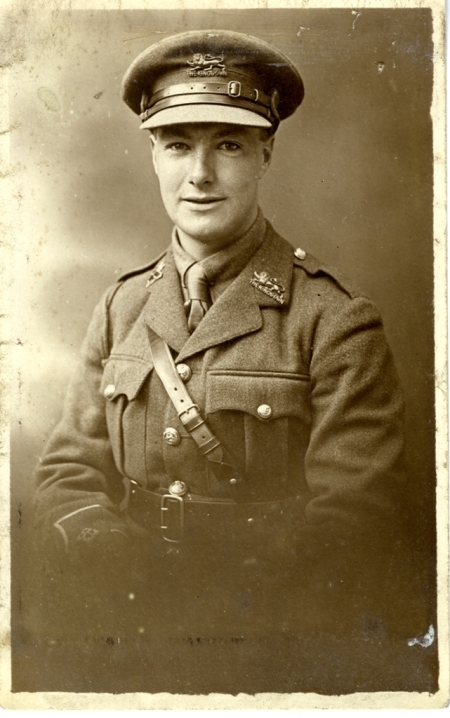
John-Charles-Beswick-last-known-pic-circa-1917-France074, one of the many Fota pictures on the excellent Fota House website (Source: Fota House)
More can be found at the Fota Stories website and in the book Aspects of Fota: Stories from the Garden, by Jennifer McCrea and Laura Murtagh, available from Fota House. A photograph of his grave exists on the TWGPP website and his CWGC entry lists no inscription on his headstone from his family.
5. Charles Hubert Brown, March 26 1918
Private Charles Hubert Brown, Royal Garrison Artillery (and Royal Sussex Regiment) died on the same day as a fellow Kew Gardener and gunner, James William Clark (see below).
Brown entered Kew from the gardens of Court Close, Eckington in September 1914, possibly as result of vacancies created by enlistment of Kew men. He had been rejected as medically unfit for the army owing to heart trouble. He tried to enlist twice more whilst at Kew, finally succeeding at the end of 1916. He died in hospital in France on the 26 March, 1918 as a result of shrapnel wounds to the head, according to his Kew Guild Journal 1919 obituary.
In the Kew Guild Journal it mentions “we had no further news of his movements” – so maybe this is why his regiment varies in listings. Charles Hubert Brown, 290133, 11th Battalion Royal Sussex Regiment died on 26 March 1918 and is buried in plot VII.AA. Dernancourt Communal Cemetery Extension.
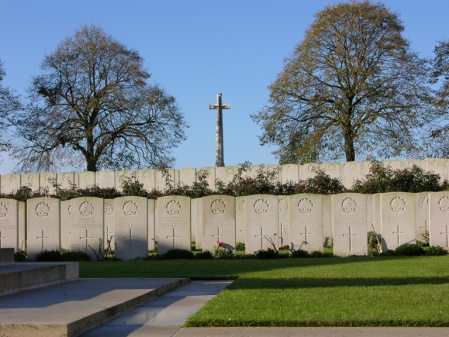
Gunner Brown lies in the graves to the left of the cross at Dernancourt Communal Cemetery Extension. (Image: CWGC website)
Brown appears to have died in hospital just as this hospital and cemetery were being evacuated. The CWGC history of the small cemetery and the larger extension where Brown is buried says that Field ambulances used the Dernancourt Communal Cemetery for127 Commonwealth burials from September 1915 to August 1916, and again during the German advance of March 1918. The XV Corps Main Dressing Station was formed at Dernancourt in August 1916, when the adjoining Communal Cemetery Extension was opened. The 3rd Casualty Clearing Station came in March 1918 but on 26 March (when Brown died), Dernancourt was evacuated ahead of the German advance. The cemetery extension remained in German hands until the village was recaptured on 9 August 1918 by the 12th Division and the 33rd American Division.
Looking at the Graves Registration Documents on his CWGC entry (documents which would have been compiled by part of the Graves Registration Unit where several Kew staff worked such as C P Raffill), the list for Plot 7 Row AA of Dernancourt Communal Cemetery Extension is full of the names of 26 March 1918 casualties, the date dittoed down the page. Charles Brown has no added inscription on the headstone from his family. A photograph of his grave exists on the TWGPP website.
6.
Private John Mackenzie Campbell, 204th Canadian Beavers Infantry Battalion
He died and is buried in Toronto (St. John’s Norway) Cemetery, Toronto, Canada in 1915. His 1917 Kew Guild Journal obituary lists him as dying aged 36 of sunstroke whilst training in Canada, where he worked for the Toronto Parks Department. He was born into a family of ten children of Mr. Roderick Campbell of Ardross, Lanarkshire and the late Isabella Campbell. His private headstone exists amongst other IWGC / CWGC headstones, a photograph exists on the TWGPP website.
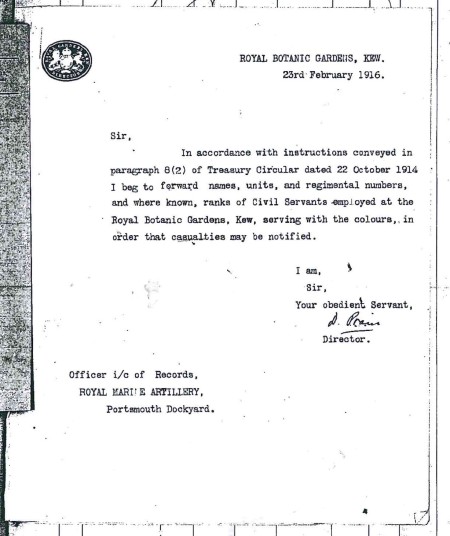
From J W Clark’s Royal Marine (National Archives) records, a curious note in 1916 from Kew Director David Prain re his staff records.
7. James William Clark, 26 March 1918
Gunner James William Clark, RMA/1656(S), Royal Marine Artillery, Howitzer Brigade, died 26 March 1918, aged 26. He is buried at Grave Reference VI. D. 8, Faubourg D’Amiens Cemetery, Arras. He joined the Royal Marine Artillery in January 1916.
Clark is listed as the son of James William and Elizabeth Clark, of The Gardens, Torre Abbey, Torquay where James also worked before Kew amongst a number of Torquay posts at Braddon’s Hill Nursery and Normount Gardens. He was born on August 24, 1891. Clark entered Kew in January 1913,working as a seed collector in the Kew Arboretum before working as Sub-Foreman Decorative Indoors at the end of 1914.
Clark is also remembered on his local primary school memorial, which Margaret Forbes-Hamilton and other ‘churchyard friends’ in Torquay are having restored. This memorial stone of Carrera marble in the churchyard in Torre to the fallen from the local primary school includes James William Clark, who was a young gardener at Kew and whose father was the gardener at Torre Abbey. The Friends are focusing on this young man to do a more detailed study on Clark. Clark was an only child, though had many cousins, and his parents must have been devastated at his death; the inscription on his Commonwealth War Graves Commission headstone chosen by his family reads: “Thy will be Done. Dear Boy.” A photograph exists of his headstone on the TWGPP website.
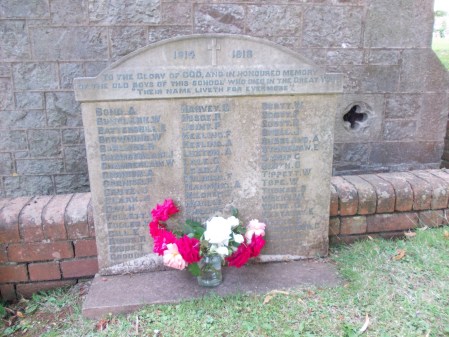
James William Clark is recorded on his school war memorial, currently being restored, Torre / Torquay (Source: Margaret Forbes-Hamilton)
The Commonwealth section of the Faubourg D’Amiens Cemetery was used by field ambulances and fighting units until November 1918. The cemetery was enlarged after the Armistice when graves were brought in from the battlefields and from two smaller cemeteries in the vicinity. The cemetery contains over 2,650 Commonwealth burials including Gunner Clark. It is pictured next to the Arras Memorial (where other Kew casualties are remembered) which commemorates almost 35,000 British and Commonwealth servicemen who died in the Arras sector between the spring of 1916 and 7 August 1918 and have no known grave. The most conspicuous events of this period were the Arras offensive of April-May 1917, and in the chaotic fighting and German breakthroughs of the spring of 1918, when Clark was killed.
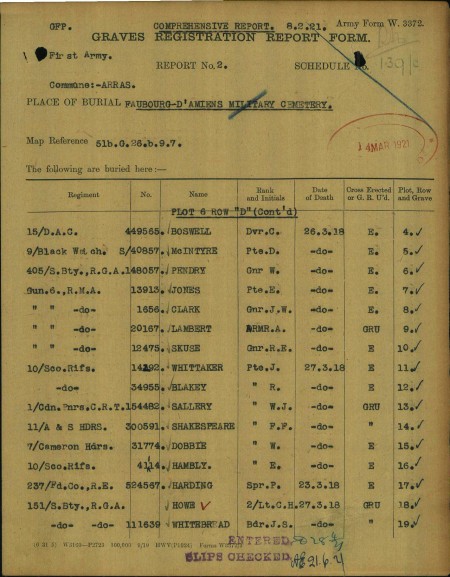
James Clark lies in a row with comrades from No. 6 Gun, Howitzer Brigade, Royal Marine Artillery who died on 26 March 1918, amid the names and headstones of thousands of casualties from the March 1918 battle. Source: CWGC website
Looking at the Graves Registration documents and Faubourg cemetery records for Plot VI or 6, Row D amongst the several thousand headstones and many thousands more names on the Arras Memorial , over 37,000 names, it is possible to see that James Clark lies in a row with comrades in a small cluster of burials from No. 6 Gun, Howitzer Brigade, Royal Marine Artillery who all died on 26 March 1918. Clark lies alongside Gunner A.E. Skuse (or Skuce), Pte E.Jones, A. Lambert (Armourer’s Crew Royal Navy “HMS Excellent”) showing the strange mixture of units, ranks and nationalities (West Country English, Welsh, Scottish) that made up the crew of this one gun in a strange Royal Marine or Navy unit. Other Officers and Gunners from the Royal Garrison Artillery Siege Battery brigade are buried in the same row from the same fighting.
I can find none of his RMA gun crew listed as missing on the Arras Memorial. Two other Royal Marine Artillery men Gunners. D. Evans and H. Hancock died at the 8th & 19th Casualty Clearing Stations and were buried at its associated Duisans Cemetery, Etrans although there is no certainty they were from Clark’s section or gun crew.
I have an especially personal interest in the 26 March and the March 1918 battles, as Gunner Clark and Gunner Brown of the Kew staff died or were killed on the same day in March, during the same battle and not far from my Great-Uncle J.W.Ansell of the 7th Battalion, Royal Sussex Regiment. Unlike Gunner Clark, Private Ansell has no known grave and is recorded on the nearby Pozieres Memorial. Gunner Clark and Gunner Brown, like my uncle, are likely to be some of the many troops from reserve areas or far behind the lines who found themselves hastily flung into the March 1918 battle when British frontlines were isolated, overrun and penetrated many miles deep by an unexpected German attack.
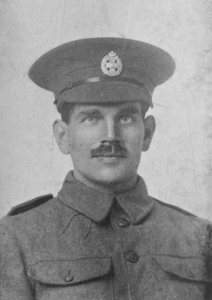
Sydney Cobbold of the 8th Battalion, Rifle Brigade died 3rd October 1916, Somme area (Source: Kew Guild photo / Kew Gardens Archives)
8. Sydney George Cobbold, 3 October 1916.
Sergeant Sydney George Cobbold, S/12906, 8th Battalion, Rifle Brigade died on the 3rd October 1916, aged 28. His 1917 Kew Guild Journal obituary lists from his letters back to Kew that he had enlisted in the Rifle Brigade by June 1915 and shortly after November 1915 embarked for France.
He is buried at Grave Reference II. B. 7, Le Fermont Military Cemetery, Rivière, a front line cemetery of 80 burials begun by the 55th (West Lancashire) Division in March 1916 and closed in March 1917. Looking at the Graves Registration GRU documents, it appears that on the same day that Sgt Cobbold was killed, 4 other 8th Rifle Brigade were killed and buried in the same plot 2 Row B of this front line cemetery alongside him – Rifleman L.J. Farr, W.G. Kittle, Benjamin Gordon (Jewish star in place of a cross) and fellow sergeant J.R. Aspden, Military Medal. Cobbold lies among his comrades and his men.
His CWGC entry lists his inscription from his father Maurice as “His Country Called / He Answered” and a TWGPP photo exists of his headstone.
Sidney was the son of Maurice and Anna Cobbold, of Woolpit, Suffolk where he was born. It was his ‘Birtle’ relative Sarah Cobbold who posted the initial Kew Gardens list of WW1 dead on Rootschat that greatly helped my research. Cobbold was at Kew from 1906-1908.
His CWGC entry lists his inscription from his father Maurice as “His Country Called/ He Answered” and a TWGPP photo exists of his headstone.
Sarah Cobbold informed me as part of her ongoing family research that “Of his siblings … older brother Arthur Cobbold was curator of the Charles Darrah collection of cacti at Alexandra Park Manchester for 30yrs+ until his retirement in 1934. Although Arthur did not see active service, he contributed to the war effort by giving talks in Manchester on topics such as ‘Help the war, help your country, help yourselves By growing vegetables’.” Very interesting in view of our blog posts as a WW1 precursor to the WW2 Dig For Victory efforts. There is also a Cobbold family trust which mentions Sydney Cobbold: http://www.eadt.co.uk/news/features/family_tribute_to_the_cobbolds_who_fell_1_87084
9. Harry or Henry Sydney Cockcroft, 11 December 1919
Lance Corporal Harry Sydney Cockcroft P/14540, Corps of Military Police Home Command.
Cockcroft is listed on the Kew Memorial as ‘Military Foot Police’. Elsewhere he is listed as Royal Fusiliers. He is listed as a Present Kewite in 1914/15 under the section “Gangers, labourers and boys”.
He died of sickness, aged 35 on 11 December 1919. Several spellings of his name including Sidney exist.
In the Kew Guild Journal 1920, p.482, the article on the War Memorial mentions that “Two additional names have to be added to the Tablet. Pte. Albert Wright and L.Cpl. Sidney Cockcroft.”
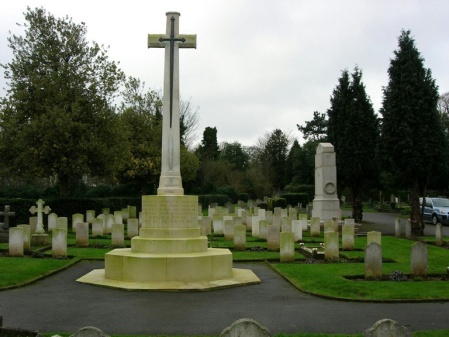
Several Kew staff are buried in Richmond Cemetery, not so far from the Royal Botanic Gardens Kew.
(Image: CWGC website)
The son of Mr. & Mrs. Anne Cockcroft of Wathamstow, and husband of Mrs. Mabel Cockcroft of 84(?the) Green, Kew. He is buried in Richmond Cemetery and commemorated on the Richmond War Memorial, Surrey.
10. Private Ernest Richard Collins, Middlesex Regiment
Listed as one of “six Members of the labouring staff killed in action” in the Kew Guild Journal 1919 Roll of Honour. If this is a correct transcription of his name, I have discovered a Lance Corporal 493195 County of London Battalion (Princess Louise’s Kensington Battalion), London Regiment, also listed as 13th Kensington Battalion and possibly 4073, 8th Battalion, Duke of Cambridge’s Own (Middlesex) Regiment. He is listed on the Brentford Memorial (see the Roll of Honour website). He married Amy Washington in 1905 and Amy Collins is later listed as living at 58, Brook Road, Brentford, Middlesex. He is listed as the son of Daniel and Mary Collins, Tavistock, Devon.
Collins was killed in action on 17 February 1917 and is buried in Grave IV.D.6 of St. Vaast Post Military Cemetery, Richebourg-L’Avoue.
11. Sidney George Comer, September 22 1918
Private Sidney George Comer, Machine Gun Corps and Tank Corps, USA
This Kew man had gone out to work in the USA in February 1914 after working at Kew from February 1911 as Sub-foreman in the Propagating Pits at Kew. He is listed as a boarder at 1 Gloucester Road, Kew in the 1911 census, alongside two other young gardeners, Joseph Sharps of Ness, Chester and Edward Plummer Heim of Purton, Wilts. All three young gardeners grandly signed their 1911 census returns as “Gardener, Royal Gardens, Kew“.
Sidney Comer was born in February 1889. His father J.C.Comer was a wheelwright on the Killerton Estate, Exeter, Devon. His Kew Guild Journal obituary of 1919 notes that he was “one of 6 sons … all serving in the forces”. Although many Comers are listed as casualties on the CWGC.org site, I have thankfully not so far found any other of his brothers listed as killed.
Comer died of pneumonia on September 22, 1918 whilst in training at Camp Devens, Massachusetts, after enlisting in the US army once America entered the war in 1917. Many serving troops died during the Spanish Flu / Influenza epidemics which swept around the world in the chaos at the end of the war.
As well as service at Killerton, Comer had also worked before going to Kew at Boconnoc near Lostwithiel, home today to a famous spring garden festival each April by the Cornwall Gardens Association. Married in 1916, his wife predeceased him in June 1918, probably in America.
12. John Dear (Junior), died 31 March 1919
Sergt John Dear, East Surrey Regiment
John Dear, Junior was listed amongst the “Constables and porters” on the Kew staff in 1914. In the 1911 Census he is listed as a ‘Herbarium Porter, Royal Gardens, Kew’. His father John Dear (Senior) was a ‘Garden Labourer (Ganger)’ at Royal Gardens, Kew in 1891 to 1911. The 1915 Kew Guild Journal, page 195 mentions that “a number of the Constables and Porters who have rejoined the colours are Non-Commissioned Officers acting as Instructors in the New Army”. John Dear himself appears to have served in the 3rd Battalion, East Surrey Regiment (time expired), according to his surviving Service papers.
Born in 1887, Sergeant John Dear 4440 enlisted in Richmond in the 9th Battalion, East Surrey Regiment (the local regiment for many Kew staff) on 28 September 1914, was quickly promoted and went to France on 31 August 1915. Sergeant Dear was wounded (possibly ‘GSW gun shot wound right arm’, fairly illegible entry) and sent home to Britain around 9 April 1916 after 221 days service in France. He was discharged from St. George’s Hospital (Staines) hospital on 19 Oct 1916 “permanently unfit … given £1 and a suit of plain clothes”.
He was finally discharged by the army (‘character – very good’) in 8 November 1916, presumably due to his wounds. Along with an Army pension (entry partly illegible but finishes 18 shillings weekly for life). John Dear was also issued with a War Badge No. 81696 and Certificate No. 2067, presumably to help him avoid the white feather. I cannot find him listed on the Commonwealth War Graves Commission website, as he was discharged as wounded and no longer fit for service. As he died after the war as a civilian, buried in Richmond (see pictures on the International Find a Grave website http://www.findagrave.com/cgi-bin/fg.cgi?page=pv&GRid=57172409&PIpi=45438317) he may not have been recorded as a war grave.
John Dear was married on 18 April 1912 in Richmond to Ethel Warry (born Notting Hill, 3 June 1889 and died September 19176, Hounslow) and they had one son, Ernest John in Chiswick (born 28 January 1913, died November 2003 in Ealing, Middlesex). By the early 1920s, Mrs Ethel Dear was signing for receipt of his medals (the trio of the 1914-15 Star, Victory and British War Medal), living in 27 Cambridge Road, Chiswick, Middlesex. She received a 11s 4d weekly rate pension as a a war widow from November 1919. What he died from is not yet clear to me. I cannot currently find a Kew Guild Journal obituary for him. Another possible relation is Kew Gardens storekeeper, George Dear, employed at Kew from 1884.
The Census lists John Dear living at 2 York Villas, Kew in 1911 with his father, his mother Annie Elizabeth Dear (nee Gregory, b. 1860 in Rotherham) and five sisters and brothers – Emma (b. around 1892), Mabel (b. 1896), George William (b.1898), Alfred Edward (b. 1899) and Herbert (b.1902). Three other children did not survive childhood.
Sergeant John Dear’s three brothers survived the war. His wife Ethel’s younger brothers Albert Charles Warry and Samuel James Warry did not, both being killed in the fighting in March and September 1918. They are listed on the CWGC website.
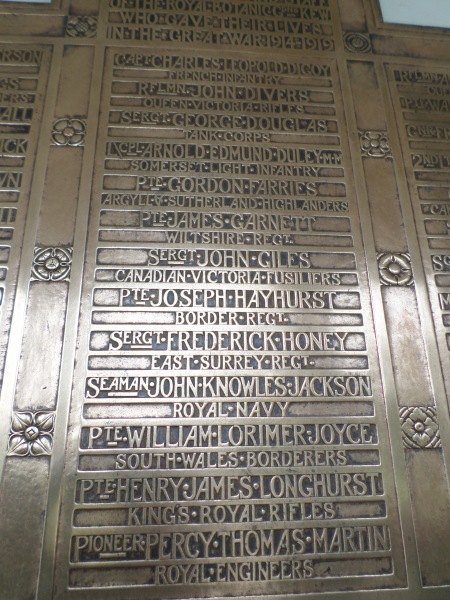
Second panel, Kew Gardens War Memorial D – M
C.L. Digoy to P.T. Martin
Image: Mark Norris, World War Zoo Gardens Project
13. Charles Leopold Digoy, 28 September 1917
Captain Charles Leopold Digoy, Chevalier of the Legion of Honour and Russian Cross of St Ann. 14th French Infantry Brigade.
Born 18 February 1890, Digoy served in the French Army and was killed at the battle of Morourvilliers, Champagne on 28 April 1917. Wounded early in the war on 24 December 1914 and decorated several times during his three years service, Digoy was a high achieving student at the Versailles National School of Horticulture 1906 – 1909 before transferring to Kew from May 1912 until August 1914 when he joined the French Army, writing to the Kew Curator: “our military service is the most troublesome but also the most sacred of a Frenchman’s duties”. A letter about his war service is published in the 1917 journal and his obituary in the 1918 Kew Guild Journal.
An oak from the French battlefields at Verdun was planted near the Kew Gardens War Memorial from seeds harvested in 1917 by the Mayor of Verdun to be sold for the Red Cross. Three such Peace trees were planted at Kew on Peace Day July 1919 or 1920.
In research for our joint article in the Kew Guild Journal 2015, Kew and the First World War – 100 years on by James Wearn and Mark Norris, James discovered that:
Digoy was a French Kewite and a gardener at Kew from 6 May 1912 until he left to serve his country. Before joining Kew he had written no fewer than six letters begging to join the gardens, until a vacancy opened. In his letter of resignation from Kew, regarding his call-up he stated earnestly: “Our military service is the most troublesome but also the most sacred of our duties, France could not do without and whatever inconvenience it puts us to we must accept it as incumbent on our nationality.” His heroic actions feature within the chronicle of his regiment’s history (Historique du 14e Régiment d’infanterie, Édouard Privat, 1920).
James also discovered a French memorial site for him: http://www.memorialgenweb.org/memorial3/html/fr/complementter.php?id=3405246
14. John Divers, 9 October 1916
Rifleman John Divers, service number 7056, 1st / 9th Battalion, London Regiment (Queen Victoria Rifles) and also County of London Cyclists, died on 9th October 1916 when his patrol into No Man’s Land towards the German trenches was wiped out. For a time he was “missing, believed killed” and an officer wrote to his father that they had not been “able to thoroughly search the ground” for his body.
As a result Divers has no known grave and is one of two Kew Gardens casualties (with H.M. Woolley) listed amongst the missing of the Somme Battles on the Thiepval Memorial at Panel Reference Pier and Face 9 C. John Divers is listed amongst over 72,000 men from the UK and South Africa who died in the Somme area before March 1918 and who have no known grave. An excellent Thiepval database exists to put faces to names and add to the publicaly available knowledge about these 72,000 men.
At the end of September, Thiepval village was finally captured from the Germans, one of the original objectives of the disastrous first day of the Battle of The Somme on 1st July, 1916. Attacks north and east continued throughout October when John Divers was killed and into 18th November in increasingly difficult winter weather. Over 90% of those commemorated on the Thiepval Memorial died like John Divers between July and November 1916.
Having visited this Thiepval memorial, it is like many of the other memorials to the missing such as the Ypres Menin Gate, quite overwhelming to scan the panels ccontaining thousands of carved names.
Born 7 August 1891 at Redhill in Surrey, he was the only son of a gardener and amateur botanist Mr Jos. Jas. Divers. From a well known family of gardeners, Divers worked with his uncle W.H. Divers VMH at Belvoir Castle, Grantham before joining Kew, March 1912, quickly becoming a Sub-foreman, Herbaceous and Alpine Dept. He was killed on the same day as fellow Kewite H.M. Woolley. (Thanks to his relatives for some of this background family / genealogical information).
15. George Douglas, 20 November 1917
Serjeant or Sergeant George Douglas, Tank Corps is buried at Cambrai Memorial, Louverval in France, a memorial to the missing or those with no known graves from the Battle of Cambrai in November and December 1917. He died on 20 November 1917, aged 40. He served as Serjeant, 93045 with E Battalion, Royal Tank Corps having originally been with the 2/3 or 23rd Scottish Horse. Other websites such as the Tankmen of Cambrai website have him listed as a Corporal, with much more fascinating information about the early Tank Corps crew and this battle.
Of the 35 Mark IV British tanks which went ino action crushing wire and supporting Scottish troops of the Highland Brigade in the attack on the German occupied village of Flesquieres, 28 tanks were put out of action by enemy fire or had broken down by the end of the first day, the 20th of November. 29 were killed and 31 tank crew missing including Sergeant Douglas, 64 others were wounded.
In the 1914 Kew Guild Journal he is listed as an Old Kewite, having entered Kew in November 1899 from Lowther Castle Penrith. He went with fellow young Kewite James G. Duncan (who entered Kew 1900 from Glenart Castle, Co. Wicklow) as Assistants in the Municipal Garden, Port Elizabeth, South Africa. The Kew Guild Journal (1901) notes that Duncan and Douglas have both joined the Town Guard in South Africa during the Boer War on the British side.
He enlisted again in WW1 in Edinburgh into the Scottish Horse before joining the Tank Corps. He was born in Selkirk around 1877, the son of Mr & Mrs James and Agnes Douglas of 15 Green Terrace, Selkirk and husband of Lydia E. Douglas (nee Chaplin) of 13 West Mayfield, Edinburgh.
According to a post on the Scottish War Memorials Trust website, George Douglas was one of four brothers from the same family to die in the First World War. The others were Gunner T. Douglas, 776624, 310 Brigade, Royal Field Artillery killed on 15 April 1917, HAC Cemetery, Ecoust St. Main, France; Private John Sanderson Jardin Douglas, 10225 2nd Battalion, KOSB, died aged 25 on 13 October 1914, Le Touret Memorial; Sergeant J H Douglas, S/1774, 3rd Battalion, Seaforth Highlanders, died 17 October 1918 and buried in Selkirk (Shawfield) Cemetery.
16. Arnold Duley, 14 March 1918
Lance Corporal Arnold Edmund Duley, M.M., 17583, 7th Battalion, Somerset Light Infantry (died as a Prisoner of War)
Arnold Edmund Duley (Edward or Edmund Arnold in some records) died as a Prisoner of War on 14 March 1918 aged 33 in hospital at Tournai in Belgium, probably from being “badly fed and probably had to work in a weak state” by the Germans. Food parcels from the Kew Guild through the POW fund probably never reached him in time, his Kew Guild Journal obituary in 1919 laments. He is buried in Tournai Communal Cemetery Allied Extension, plot IG1, his headstone pictured on the TWGPP website.
A “rather short young man of quiet disposition”, Duley returned from his post as Head Gardener to HSH Prince George of Russia at Haraks, Yalta, Crimea (1911 – 1914) to serve with his county regiment, the 7th Battalion Somerset Light Infantry, gaining the Military Medal. This medal is reported in the Western Daily Press, Bristol, Tuesday January 23 1917 and later Duley is reported as wounded in the Western Times 28 December 1917.
I have not yet found his WW1 service records but his WW1 medal record card reveals that Arnold Duley entered service in France with the 7th Somerset Light Infantry on 18 August 1915, gaining a 1915 star alongside the standard Victory and British war medals, not forgetting his Military Medal. The Medal record card lists him as ‘Died of Disease 14 March 1918’.
A page from The Kew Guild Journal 1918 records money being sent by Duley whilst serving in the trenches to buy POW parcels for his friend Guy Neville, a Kewite civilian internee at the famously horticultural internment camp at Ruheleben in Germany. The same 1918 page also ironically records aid being sent to Duley when he became a Prisoner of War at Gefangenlager, Dulmen, I.W. Westphalia Germany. In February 1918 he was sent to work as a POW in Belgium.
After service at Codicote Lodge Gardens, Welwyn, Herts Arnold Duley was at Kew from 1906 to 1908, then served in the Cardiff Parks Department. Arnold Duley is listed on CWGC as the son of George Edmund and Elizabeth Ann Duley, 9 High Path, Wellington, Somerset (hence his county regiment). He is listed on the SDGW Soldiers Died in The Great War listing as born and enlisting in Wellington Somerset.
His Probate and Will leaving £87 were administered by Janet Elizabeth Duley, spinster (his younger sister and only sibling, an Art Student living at home in the 1911 census at 6 High Path, Wellington). His father George (b. 1856, York) was an accountant in a woollen factory, his mother Elizabeth (Somerset / Bristol born 1854). In 1911 Arnold Duley was living in Cardiff as a Gardener, Cardiff Parks Deprtment as one of two single boarder / lodgers in the house of Park Keeper Robert Stewart Trevarthen.
Buried as a Prisoner of War by the Germans, Duley appears to have been reburied or at least the grave remarked with a British headstone. Originally buried by the Germans, he was reburied with a CWGC headstone with no family inscription. The Concentration document / reburial forms are lists of individuals who have been exhumed from their original burial location and reburied in a particular cemetery such as Tournai. These record details of individuals who were originally buried in smaller or isolated cemeteries, but who, at a later date, were exhumed and reburied in war cemeteries. The concentration of cemeteries allowed otherwise unmaintainable graves to be moved into established war grave cemeteries where the Commission could ensure proper commemoration. These forms provide basic details of the individual, but in addition may also include information as to their original burial location and occasionally some details of how they were identified. These additional details would have been omitted if the individual was reburied in the same cemetery or identified using normal methods, for example via a service tag.
Tournai was captured by the German II Corps on 23 August 1914 and the town remained in German hands until it was entered by the 47th (London) and 74th (Yeomanry) Divisions on 8 November 1918. . During the occupation, the Commonwealth and Allied wounded were cared for in the Hopital Notre-Dame. The (Southern) Communal Cemetery, in the Faubourg-St.Martin, was used and extended by the Germans, although the graves were later regrouped by nationality and some were brought in from other cemeteries in a wide area around Tournai. There is no obvious reference to a March 1918 POW death and burial such as Duley amongst the list of such cemeteries and reburials on the Tournai CWGC cemetery entry. Ironically for someone who had served as gardener to Russian Royalty in Pre Revolutionary Russia, Duley is buried in the same Allied cemetery extension as 117 Russian soldiers who died as Prisoners of War in German hands.
I have not yet found how Duley obtained his Military Medal. Hopefully the team at the excellent Somerset Remembers website will find local references. The 7th (Service) Battalion Somerset Light Infantry was formed at Taunton in September 1914 as part of K2 (KItcheners 2nd Army of volunteers) and came under command of 61st Brigade, 20th (Light) Division. On 24 July 1915 it landed at Boulogne. On his Medal record card it states that Arnold Duley entered service in France with the 7th Somerset Light Infantry on 18 August 1915.
17. Gordon Farries, 20 April 1918.
Private Gordon Farries, S/11973, 11th Battalion, Argyll and Sutherland Highlanders, died on 20th April, 1918, aged 27.
The fifth to fall of the ten Kew Sub-Foremen who joined the Army, he was at Kew from February 1913 after working at Veitch’s Nursery at Feltham. He originally joined the Royal Army Medical Corps but later transferred to a Scottish regiment. His Kew Guild Journal 1919 obituary notes that he was killed on the night of April 20-21 1918 whilst reinforcing another platoon.
Reported missing, his body was later found by men of a London Regiment fighting over the same ground. Farries is buried at Grave Reference III. G. 4, Feuchy Chapel British Cemetery, Wancourt.
Linked to the history of Farries’ missing body, this cemetery itself has an interesting story (on the CWGC website) of how the same ground was won and lost, captured and recaptured several times in the last two years of the war.
Wancourt village was captured by the Allies on 12 April 1917 after very heavy fighting, lost to the Germans in the chaos of March 1918, and retaken by the Canadian Corps on the following 26 August 1918. The cemetery was begun by the VI Corps Burial Officer in May 1917, used at intervals until March 1918, and again in August and September 1918. At the Armistice, it contained 249 graves, all in the present Plot I.
Farries is buried in Plot III (3) suggesting his grave was transferred there later. The cemetery was enlarged after November 1918 when 834 graves (mainly of April and May 1917) were brought in from the battlefields of Fampoux, Roeux, Monchy and Wancourt, and from a few smaller burial grounds. There are now 1,103 Commonwealth burials and commemorations of the First World War in this cemetery. 578 of the burials are unidentified. The cemetery was designed by Sir Edwin Lutyens.
Gordon Farries is listed as the son of ex-Baillie Thomas Charlton Farries and L. J. Farries, of 2, Gordon St., Dumfries. They chose an inscription for his headstone which reads “To Live in The Hearts of Those We Love is Not to Die“. His headstone can be seen on the TWGPP website.
18. James Garnett, 3rd August 1917
Private James Garnett, service number 11380, 2nd Battalion, the Wiltshire Regiment died on the 3rd August 1917, aged 28. He has no known grave and is listed on Panel 53 of the Ypres Memorial (Menin Gate), one of four memorials to the missing in Belgian Flanders which cover the area known as the Ypres Salient.
Garnett is listed as one of “six Members of the labouring staff killed in action” in the Kew Guild Journal 1919 Roll of Honour. He is listed as the son of Mrs. Fanny Garnett, of 6, Manor Grove, Richmond, Surrey.
The site of the Menin Gate was chosen because of the hundreds of thousands of men who passed through it on their way to the battlefields. The Memorial now bears the names of more than 54,000 officers and men from 1914 – 1917 whose graves are not known. The memorial was designed by Sir Reginald Blomfield, who also designed the Cross of Sacrifice in each CWGC cemetery worldwide above 40 casualties. It was unveiled by Lord Plumer on 24 July 1927.
During the Third Battle of Ypres in 1917 an offensive was mounted by Commonwealth forces to divert German attention from a weakened French front further south. The initial attempt in June to dislodge the Germans from the Messines Ridge was a complete success, but the main assault north-eastward, which began at the end of July, quickly became bogged down against determined opposition and the rapidly deteriorating weather. The campaign finally came to a close in November 1917 with the capture of Passchendaele.

Kew staff Garnett and Giles have no known grave and are remembered on the Ypres Memorial (Menin Gate). Image: CWGC website
19. John Giles, 23rd April 1915
CSM Company Sergeant Major John Giles ,20277, 10th Battalion Canadian Infantry (Canadian Victoria Fusiliers), died 23rd April 1915, aged 26. He was killed by a shell on active service in France on July 17, 1917.
He has no known grave and is commemorated on Panel 24 – 28 – 30, Ypres (Menin Gate) Memorial. He is listed as the son of Joseph Giles, of “Woodville,” Crowthorne, Berks, England and husband of Amy Giles, of Suite 24, Edge Block, 1211,1st West, Calgary, Alberta. He left a 7 year old son, Roy Giles.
John Giles entered Kew in November 1903 after service at Windsor Castle when Queen Victoria was alive. By 1905 he was Sub-foreman of the Orchid Department. He went to Shanghai municipal gardens in China then Vancouver and Victoria in Canada from 1912, hence his Regiment. he was variously a Private and Staff Sergeant as required in different Canadian regiments.
20. Joseph Hayhurst, 7 September 1918
Private Joseph Hayhurst, G/31695, Queen’s Own (Royal West Kent) Regiment, formerly 24251, KOSB King’s Own Scottish Borderers (Border Regiment), died 7 September 1918, aged 33. He is buried at the Unicorn Cemetery, Vendhuile, Aisne, France.
Born at Clayton Le Moors, Lancashire on 4 April 1885 to Joseph (senior) a general labourer (1901 census) and mother Ann. Joseph was listed in the 1901 census as Nursery Gardener Assistant aged 15. His brothers and sisters were cotton weavers.
Aged 25 in the 1911 Census, he was living as a boarder in 55a Moscow Road, Bayswater whilst working as a “Gardener Public” for HM Office of Works. Joseph Hayhurst enlisted at Windermere, Lancashire. He is listed on the CWGC website as the husband of Mrs. B. Hayhurst, Ebenezer Terrace, Billington, Whalley, Blackburn. There is no additional inscription from his family on his headstone, photographed on the TGWPP website.
A postwar Kew Guild Journal 1921, p.43 “In Memoriam” section records that the deaths “of W. Humphris and Mr J. Hayhurst of the Border Regiment … are recorded in the war but we have been unable to obtain any particulars”.
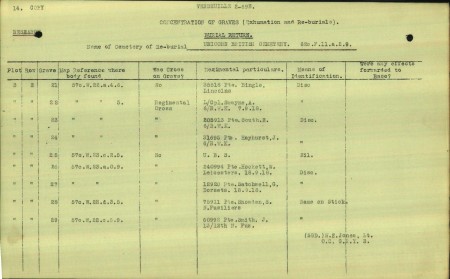
J Hayhurst’s reburial or concentration form suggest he was reburied at Unicorn from elsewhere. Source: CWGC
Hayhurst’s records suggest he was reburied at Unicorn Cemetery from elsewhere, alongside regimental colleagues, each recognised by their Identity disc.
21. Frederick Honey, 17 April 1917
Sergeant Frederick Honey, G/20245, 8th Battalion, East Surrey Regiment or the Buffs (East Kent) Regiment, ‘died of wounds’ 17 April 1917, aged 28. He is buried at Grave Reference I. K. 16, Chocques Military Cemetery. This was located next to No.1 Casualty Clearing Station for casualties from the Bethune area. He is listed as the son of Mr. and Mrs. T. Honey, of 64, Alexandra Rd., Richmond; husband of Ellen May Honey, of 17, Darell Rd., Richmond, Surrey.
His CWGC entry mentions no inscription chosen by family on his headstone, which is pictured on the TWGPP website. . He is mentioned in a list of “Gangers, labourers and boys” in Kew’s 1914 staff list and as one of “six Members of the labouring staff killed in action” in the Kew Guild Journal 1919 Roll of Honour.
22. John Knowles Jackson, 1st June 1916
Ordinary Seaman John Knowles Jackson, J/47092, HMS Fortune, Royal Navy, died 1st June 1916, aged 22. He is one of nine naval burials (four named) from the 1916 Battle Of Jutland buried at Farsund Cemetery, Norway. He is listed as the son of (W or) Thomas and Ann Jane Jackson, 25 Westby Street, Lytham. He was born at Lytham, Lancashire on December 4, 1893.
Jackson arrived at Kew to work in the Temperate House in August 1914 from Lytham Hall, Lancashire and left to join the Navy in March 1915. He served on several ships – Diadem, Argonaut and Hecla – before joining the destroyer HMS Fortune which was sunk in the Battle of Jutland.
His headstone is in local grey stone.
23. William Lorimer Joyce, 2nd October 1917
Private William Lorimer Joyce, 26741, 4th Battalion, South Wales Borderers, died on 2nd October 1917, aged 32. He has no known grave and is listed on Panel 16 and 62 of the Basra Memorial, in modern day Iraq. The memorial lists more than 40,500 members of the Commonwealth forces who died in the operations in Mesopotamia from the Autumn of 1914 to the end of August 1921 and whose graves are not known. Another Kew casualty, W. Humphris, not listed on the war mmemorial is recorded on the Basra Memorial (see end of post).
Born on 22 May 1885, he is listed as the son of William and Jane Joyce, of “Llanfrynach”, Holmes Rd., Hereford (Brecon). He enlisted in Wales on his return from Canada where he worked after training at Kew from March 1908 to Spring 1910. Joyce died as a Turkish Prisoner of War at Seideghan in Turkey after being captured during the fighting in Mesopotamia on April 30, 1917.
24. Henry James Longhurst, 25th September 1915
Private / Rileman Henry James Longhurst, R/7519, 2nd Battalion, Kings Royal Rifle Corps, died on 25th September 1915. He has no known grave and is listed on Panel 101 and 102, Loos Memorial.
Born on February 3 1892, Longhurst is noted in his Kew Guild Journal obituary 1915/16 as “the first of our young gardeners to give his life for his country in this war” alongside W.H. Morland, another early Kew casualty. He entered Kew on July 1913. He enlisted on November 21, 1914 and was killed in action “somewhere in France“.
25. Percy Martin, Royal Engineers, 6th March 1919?
I can find no Kew Guild Journal obituary for Percy Martin so far so will keep researching this casualty. A possible match is Pioneer Percy Martin, 128485, “H” Special Company, Royal Engineers, died on 6th March 1919, aged 32. He is buried Grave Reference F. 1000, Richmond Cemetery, Surrey. He is listed as the son of Charles Edward Martin and husband of Louisa Martin, of 10, Princes Rd., Richmond. Percy Martin is also listed on the Richmond War Memorial.
Less likely to be: Sapper Percy Charles Martin, 1471, 1st / 2nd (Kent) Field Company, died 8th August 1915, age 30. This Percy Martin is buried at Grave Reference D. XII. 4, Pieta Military Cemetery. He is listed as the son of Henry and Margaret Martin, of 1, Providence St., Ashford, Kent.
26. Arthur John Meads, 1st December 1917
Rifleman Arthur John Meads, 551182, D Company, 2nd /16th London Regiment (Queen’s Westminster Rifles), died 1st December 1917, aged 27. He is buried at Grave Reference H. 24, Ramleh War Cemetery, Palestine/ Israel. Ramleh (now Ramla) was occupied by the 1st Australian Light Horse Brigade on 1 November 1917. The cemetery was begun by medical units linked to the Field Ambulances and Casualty Clearing Stations posted at Ramleh and Lydda from December 1917 onwards. Meads died there of abdominal wounds in a Field Ambulance station around the time this cemetery and hospitals were established. His headstone (with no family inscription) could be seen at the TWGPP website.
His Kew Guild Journal 1918 obituary lists him as Sub-Foreman of the Palm House. He enlisted in January 1915 and went to France on June 1916. He was wounded on Salonika in 1916/17, before moving to Palestine in 1917. He served with three other Kew colleagues in the Queen’s Westminster Rifles. His death date is recorded as 1st December 1917 during the Second Battle of Gaza, of wounds received on November 26th 1917.
Born on 22 February 1890, he is listed as the son of John and Kate Meads, of Swallow St., Iver, Bucks and husband of Margaret Annie Meads, of Strood Villa, Broad Oak, Newnham-on-Severn, Glos.
27. Walter Henry Morland, May 7th 1915
Private 2092 Walter Henry Morland, Royal Scots.
His CWGC entry lists him as “on staff at Royal Botanic Gardens Edinburgh as a Rose Specialist“. Also trained at Kew, he is recorded on the RBG Edinburgh war memorial (amongst 20 staff who died) and the one at Kew Gardens.
It was the accidental discovery of Morland’s name whilst searching the CWGC website for ‘botanic gardens’ on the keyword search links that eventually led me to the brief Rootschat listing of the 37 Kew names and the Kew Guild Journal online site. In some future blog post I will trace more about Morland’s comrades amongst the Royal Botanic Gardens Edinburgh’s twenty WW1 casualties.
Some family history searches flesh out the life of this Rose Specialist. Morland was born in Maidstone in 1881, worked at George Bunyard’s Nursery there and the Cambridge Botanic Garden before joining Kew between 1905-07. On the 1881 and 1891 census his father William was listed as a Carrier’s Carman, his uncle Walter a bricklayer’s labourer.
By 1901 Walter Henry Morland is working as a Domestic Gardener, staying as a 20 year old single boarder at 3 Heathfield Cottages, Bletchingdon, Oxfordshire. This may have been linked to work at the local Mansion Heathfield House, next property listed on the Census return, home of one Charles Stratton and family, “living on own means” and employing a number of servants. Morland also worked at Thomas Rochford & Sons and Hyde Park before joining Edinburgh’s Royal Botanic Garden in 1909, working on the Rock Garden section when war broke out.
The April 1911 Census in Scotland (available via the Scotland’s People website) lists Morland as living a short walk and a few streets away from the botanic garden at 11 Rintoul Place, Edinburgh along with his wife of two years, Annie. They had no children at that time.
Married in 1909, Morland enlisted on August 31 1914 in the 5th Battalion Royal Scots (Queen’s Edinburgh Rifles) at Edinburgh. He was killed during the Dardanelles campaign against the Turks, surviving the landings on April 25th 1915 but dying during “an assault on a wood below Krythia on May 7th. For three weeks no traces of him could be found, and it was supposed he had been taken prisoner; then his chums, during an advance, found his body.”
Morland has no known grave and is remembered on panel 26-30 of the Helles Memorial at Gallipoli in Turkey.
In the Arboretum Nursery there are several young plants of Quercus Aegilops grown from acorns sent home by an officer from Gallipoli. Perhaps it will be possible to plant one of these also in the vicinity, especially as it is in Gallipoli that the first two of our members to lose their lives,Messrs. C. F. Ball and W. H. Morland, lie buried.
Along with other early 1915 casualties, the Kew Guild Journal 1916 notes Morland (alongside Henry Longhurst) as amongst the “first of our members to fall in the service of his King and Country. Such is the price of Empire.” His medal card lists him as receiving the 1915 star as well as the usual Victory and British medals.
He is listed on the CWGC website as the son of the late William and Mrs. E.S. (Sarah) of Maidstone, and husband of Annie M.E. Morland of 6 Astley Street, Maidstone. Annie Mary Eliza Morland (1878-1960) lived on at this Maidstone address (the house appears to have now gone) until her death in 1960. They appear to have married probably in Cambridge whilst he worked at the Botanic Gardens there in 1909 before joining Kew.
28. Frederick Thomas Pursell or Purssell, 4 April 1917
Gunner / Sergeant Frederick T Purssell or Pursell, 51510, Royal Field Artillery,
70th Bty. 34th Army Brigade, died 4 April 1917 in Ypres. He is buried at Grave Reference IX. F. 16, Vlamerthinge New Military Cemetery, Belgium. Just outside the normal range of German shell fire, the village was used both by artillery units (such as Pursell belonged to) and field ambulances. There is no family inscription on his headstone, pictured on the TWGPP website.
Listed as one of “six Members of the labouring staff killed in action” in the Kew Guild Journal 1919 Roll of Honour. In the 1911 census Purssell is listed as a Stable Hand (Student Part Time) at the “Royal Gardens Kew”. He was born in Surrey around 1894 to a father Roger Purssell who was a bricklayer, living at Pond Cottage in Kew.
CWGC Graves registration documents reveal that he was killed or died on the same day as 3 others of his 34 Army Brigade Royal Field Artillery colleagues, Wainwright, West and Cronin lie buried alongside him.
One of several brothers, he is listed as being in the Royal Horse Artillery and Royal Field Artillery, arriving in France on 29 August 1915. His experience with horses may have been useful in largely horse drawn artillery regiments. Another Kew Casualty Frank Windebank (see below) was listed as a ‘Pony Boy’.
He is listed as married to Sarah Maria Grant on 29 August 1915 in (St.Paul) Brentford (the same day as he embarked for France?) Purssell is listed on his marriage certificate as a “Soldier, RFA living at 7 Albany Road”. He is also listed on the Richmond War Memorial (see Roll of Honour website).
29. Munro Briggs Scott, 12 April 1917
2nd Lt. Munro Briggs Scott, 12th Battalion, Royal Scots, died 12 April 1917. Scott is commemorated on Panel Reference Bay 1 and 2 of the Arras Memorial. M.B. Scott was most likely killed in the major Battle of Arras offensive planned for April-May 1917. The Arras Memorial commemorates almost 35,000 servicemen from the United Kingdom and the Commonwealth who died in the Arras sector between the spring of 1916 and August 1918 and have no known grave.
Born at East Wemyss, Fife, Scotland, Scott was on the Herbarium staff at Kew around the outbreak of war. He joined the East Surrey regiment in February 1916, then the Suffolk Regiment before joining the Royal Scots as an officer. Married in late 1916, he was posted to France on January 9, 1917 and killed by a high explosive HE shell three months later on 12 April 1917 at the Battle of Arras.
30. Robert Service, 28th September 1918
Gunner Robert Service, 1257927, 4th Canadian Trench Mortar Battery, Canadian Field Artillery, died 28th September 1918. He is buried at Grave Reference I. D. 18, Bourlon Wood Cemetery. There is no family inscription on his headstone, which is pictured on the TWGPP website.
Bourlon Wood and the village were the scene of desperate fighting in the Battle of Cambrai 1917 (where fellow Kewite George Douglas died). At the end of the Battle of Cambrai, British troops were withdrawn from Bourlon; and the wood and the village were ultimately retaken by the 3rd Canadian and 4th Canadian Divisions on the 27th September 1918, the day before Service died. Bourlon Wood Cemetery has nearly 250 burials – Service is surrounded by Canadian casualties – and was started by the Canadian Corps Burial Officer in October 1918, burying the mostly Canadian dead of this action. 274 metres South-West of the cemetery is a Battlefield Memorial erected by the Canadian Government to recall the forcing of the Canal du Nord by the Canadian Corps on the 27th September 1918 and the subsequent advance to Mons and the Rhine.
31. Henry James Smith, 10 October 1915
Serjeant Henry James Smith, Service number 24, 7th Battalon, East Surrey Regiment, 10 October 1915, aged 37. He is buried at Grave Reference I. L. 37, Vermelles British Cemetery, France.
According to his CWGC record, his headstone has the inscription from his wife “Memory is the only thing that grief can call its own“. The headstone is pictured on the TWGPP website.
During the Battle of Loos, when Smith was killed, Vermelles Chateau was used as a dressing station and Plot I was completed first. Smith and fellow Kewite Frank Windebank are buried a few graves apart with other 7th East Surreys) It was laid out and fenced by the Pioneers of the 1st Gloucesters, and known for a long time as “Gloucester Graveyard“.
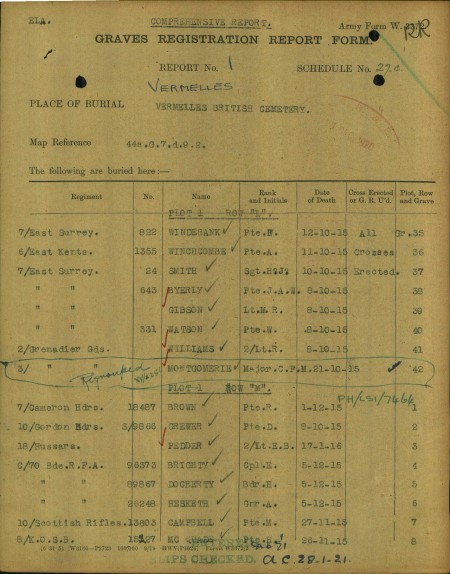
Fellow Kewites Henry Smith and pony boy Frank Windebank are buried a few garces apart having died the same day (despite the dates above) in Vermelles. It was corrected on later documents. Source: CWGC
Henry is listed as the husband of C. E. Smith, of 6, Enmore Villas, Fourth Cross Rd., Twickenham. He was CSM of the same battalion and regiment as fellow Kewite Frank Windebank, who died the same day. Both are listed as one of “six Members of the labouring staff killed in action” in the Kew Guild Journal 1919 Roll of Honour. An earlier mention notes:
“Two employees from the Gardens were killed in action in France on the same day, Sergeant H.J. Smith, a garden labourer, and Private F. Windebank, pony boy, both of the East Surrey Regiment”.
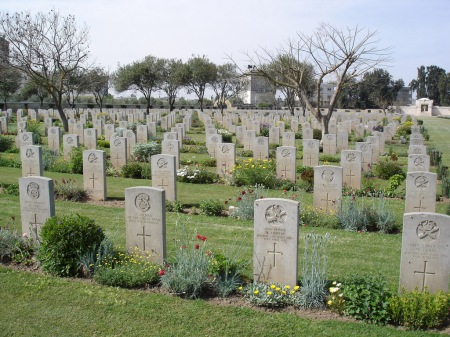
Herbert Southgate is buried amongst fellow Norfolks in a block towards the rear left of these graves in Gaza Cemetery, Israel / Palestine. Source: CWGC
32. Herbert Southgate, 19 April 1917
Serjeant Herbert William Leonard Southgate, 240701, ‘A’ Company, 1st/ 5th Battalion, Norfolk Regiment, died on 19 April 1917, aged 28. He is buried at Grave Reference XXX. F. I, Gaza War Cemetery.
He most likely died during the Second Battle Of Gaza (17-19 April, 1917) fighting against the Turks and was posted missing until his body was found seven months later and buried by British troops. Gaza was finally recaptured in November 1917. He served with his younger brother.
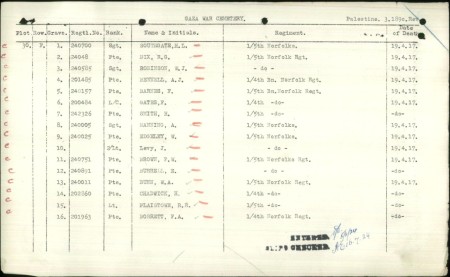
Herbert Southgate’s grave is surrounded by fellow Norfolk Regiment soldiers, killed on the same day in Gaza. Source: CWGC
Born on 19 September 1888, he is listed as the son of Herbert William and Hannah Southgate, of East Raynham, Fakenham, Norfolk (hence enlisting in a Norfolk Regiment). The inscription on his headstone from his family reads “Thanks be to God who giveth us victory through Jesus Christ”.
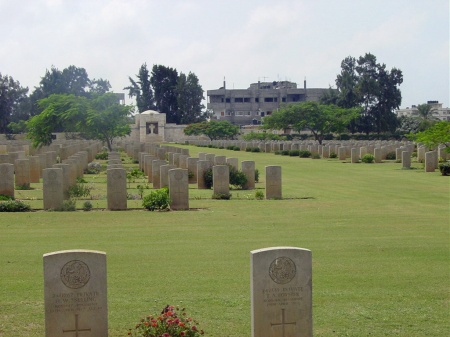
Fellow Norfolk regiment soldiers Foyster and Snelling who died on the same day lie buried near Herbert Southgate, Gaza Cemetery. Source: CWGC
Previous to training and working at Kew in 1910-12 and 1913, he had worked at Raynham Hall Norfolk and Westonbirt, Gloucestershire. He was noted as an orchid specialist. He also worked on The Gardener’s Magazine for a brief time.
33. John Leonard Veitch, 21st May 1918
Major John Leonard Veitch, Military Cross, 7th Battalion attached 1st Battalion, Devonshire Regiment, died on 21st May 1918, aged 31. Mentioned in Despatches.
He is buried at Grave Reference Row A. Grave 1, Thiennes British Cemetery, France. A photograph of his headstone can be seen on the TWGPP website. According to CWGC records, the inscription on his headstone chosen by his family is “Unto God’s gracious mercy and protection we commit thee”.
The German offensive of April 1918 pushed the front line back almost as far as St. Venant in this sector and this was one of the cemeteries made for Commonwealth burials arising from the fighting in the area. Thiennes British Cemetery was started by the 5th Division in May 1918 (when Veitch was amongst the first to be buried) and used by the 59th and 61st Divisions before being closed in August 1918. It is a small cemetery of only 114 First World War burials in the cemetery, Veitch’s grave being the first A1.
He is listed as the son of Peter Christian Massyn Veitch, J.P. Esq, and Harriett Veitch (nee Drew) 11 Elm Grove Road, Exeter of the famous Veitch nursery family.
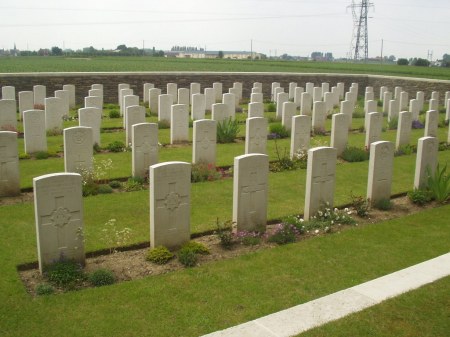
Veitch is buried first left of the front row in Thiennes Cemetery, next to Plymouth born Harold Harrison of the 1st Devonshire Regiment killed on the same day.
(Image: CWGC website)
His Kew Guild Journal 1919 obituary lists him originally enlisting in August 1914 in the 7th Cyclists Battalion of the Devon Regiment, his local regiment. He was in France from 1915, noted s being on front line duties since December 1915 and fought through the battle of the Somme in 1916. He was wounded in the shoulder at Vimy Ridge. After service in Italy, Veitch was killed by a stray machine gun bullet in the Nieppe Forest area of France on May 21, 1918. Another Devonshire Regiment man, Private Harold Harrison, lies buried beside him, killed on the same day.
A month earlier Veitch had received his recommendation for a Military Cross “for his excellent defence of the Lock, just east of the Forest of Nieppe, in the middle of April, when he stopped five attacks. He had the honour of dying in temporary command of our famous battalion.” (letter to Veitch’s father from his Colonel).
He was at Kew from 1908 to 1910, before joining the family nursery business in 1910. Educated at Exeter School, he spent time studying horticulture in Germany and Holland before entering Kew.
34. Francis Richard or Frank Windebank,10 October 1915
Private (or Lance Corporal) Frank Windebank, 822, 7th Battalion, East Surrey Regiment died 10 October 1915, aged 17. He is buried at Grave Reference I. L 35, Vermelles British Cemetery.
According to his CWGC record, there is no family inscription on his headstone, pictured on the TWGPP project website. The Kew Gardens war memorial plaque (see below) lists him as a Lance-Corporal, rather than as a Private.
Vermelles is where a fellow Kewite of the same battalion and regiment CSM Henry James Smith, who died on the same day is buried only two graves along (I.L 37). Described as a ‘pony boy‘ amongst the “gangers, labourers and boys” at Kew, Windebank was listed as the son of James and Mary Windebank, of 20, Evelyn Rd., Richmond, Surrey.
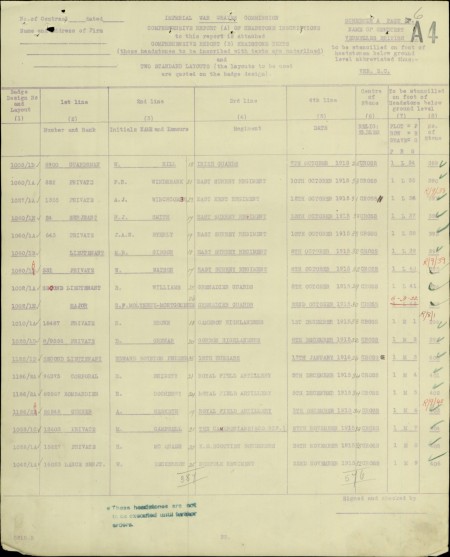
Frank Windebank and fellow Kewite Henry Smith both died on the 10th in the same regiment, 7th East Surreys, Vermelles.
Listed with H.J.Smith as one of “six Members of the labouring staff killed in action” in the Kew Guild Journal 1919 Roll of Honour. The same journal lists a possible relation, one J. Windebank listed at Kew as a carter who joined up in 1918.
Noting that Windebank was a ‘pony boy’ it was interesting to read that in timeline in the History of Kew by Ray Desmond that in August 1914 “three horses taken by Army.” In 1928 when one of the six Kew horses died, it was replaced by a motor lorry. Kew’s last Shire Horses were replaced by a team of five Suffolk Punch in 1937, both now rare breeds. By 1948 only two horses still worked the grounds, mostly mowing and hauling but being steadily replaced by motor mowers and lorries. Finally in 1961 there is a note that “Horses no longer used in the Gardens“, the year before the last Victorian Wardian cases were used for transporting plant collectors’ precious finds back to Kew.
35. John Nicholls Winn, 7th June 1918
Signaller / Private John Nicholls Winn, 365004, C company, 7th Battalion, London Regiment (Civil Service Rifles), died on 7th June 1918, aged 20. He is buried at Grave Reference X. 5629, Richmond Cemetery, Surrey. ‘Jack’ Winn is listed as the son of William Nicholls Winn (1868-1945, who worked as Assistant in the Curator’s Office at Kew) and Bertha Winn, of 87, Mortlake Rd., Kew.
According to his CWGC record, there is no family inscription on this grave. This appears to be a private headstone, rather than a standard CWGC headstone, as featured in the picture on the TWGPP website .
According to the Kew Guild Journal obituary 1919, John Nicholls Winn was born at Kew in 1898, enlisted in Richmond aged 18 in May 1916 and went to France in Spring 1917. He was wounded in the leg and died later of septic poisoning in hospital in Exeter.
36. Herbert Martin Woolley, 9 October 1916
Listed on the Kew memorial as Rifleman / Corporal Herbert Martin Woolley, “Essex Regiment” is most likely to be Rifleman 3844, 1st / 5th Battalion, London Regiment (London Rifle Brigade), died 9 October 1916. Herbert is commemorated on Panel Reference Pier and Face 9 D, Thiepval Memorial, along with fellow Kewite John Divers.
Born 27 September 1883, Herbert was the son of G.H. Woolley, Vicar of Old Riffhams, Danbury, Essex. In 1908 after working in several nurseries and Kew 1906-08 he left to work managing a rubber estate in North Borneo. He returned from Borneo to join the Essex Regiment but ditched his commission and training as an officer to become a corporal in the London Rifle Brigade to see action more quickly. His brother suggest he was also promoted to Sergeant. Herbert was killed shortly after the attack on Combles in 1916.
Herbert or “Bertie” Woolley came from a high-achieving and distinguished family of 12 children including his brother Lieutenant Colonel Sir Charles Woolley (1880 – 1960), “Woolley of Ur”,a famous archaeologist who knew Lawrence of Arabia. His brother Major George Harold Woolley VC OBE MC (1892 – 1968) was the first Territorial to win the Victoria Cross. In G.H. Woolley’s autobigraphy, “Sometime a Soldier“, Bertie’s unusual decision to become a private soldier and change regiments to get to the front quicker is described:
“While I was on sick leave my third brother, Bertie, returned from British North Borneo. He had been trained at Kew Gardens and in Germany, and then was employed on rubber plantations in Borneo. When in England he had joined the old Militia, so I had no difficulty in helping him to get a commission in the Essex Regiment. He soon tired of England, so transferred as a private to the London Rifle Brigade; he did well with them in France and was quickly made a sergeant, then offered a commission. He was killed with the L.R.B. on the Somme in 1916.
About the same time Leonard, who was doing intelligence work in Egypt, was blown up in a yacht while placing agents on the north Syrian coast. He was rescued, but as a Turkish prisoner, and spent two years of bitter captivity at Kedos and Kastamuni.
Also in 1915 Kathleen, my fourth sister, made her way across Russia to take up a teaching appointment in a school in Tokyo. After leaving Somerville College, Oxford, she had been trained for this work by the Society for the Propagation of the Gospel. Rachel, my fifth sister, was also now teaching in England. She had taken a degree at St. Andrew’s University and then went for teacher-training to St. Hilda’s at Oxford. Later she went to a school in Jamaica, and was subsequently head mistress of a diocesan school in India. My other two sisters, Edith and Marjory, were at home looking after my father at Old Riffhams, as well as coping with five or more officers of the Gloucester Regiment (T.A.), who were billeted in the house. A company of their men were in the barn. Most of the Gloucester Brigade were in huts on Danbury Common. Later in the war Edith married Harry Laxton, one of the officers who had been billeted in our house, and Marjory went to live in New Zealand.”
G.H. Woolley, Sometimes A Soldier. London: Ernest Benn, Ltd., 1963, pp. 38-39
His brother George Cathcart Woolley (1876-1947) worked in Borneo (like Herbert Martin Woolley) as a Colonial Administrator and Ethnographer. Part of his collection formed the Sabah Museum. He was interned and harshly treated by the Japanese as a POW. A quite remarkable family!

Albert Wright of Birmingham and Kew Botanic Gardens Remembered on the WW1 section Kew Gardens staff memorial (Image Source: Mark Norris, World War Zoo gardens project, Newquay Zoo)
37. Albert Wright, 25 February 1919
Private Albert Wright, 201656, 2nd /7th Battalion, Royal Warwickshire Regiment, died 25 February 1919, aged 29. He is buried at Grave Reference Screen Wall B10. 9. 661A, Birmingham Lodge Hill Cemetery. This wall carries the names of those buried in the main CWGC war graves main plot B10 or in graves elsewhere in the cemetery which could not be individually marked. A photograph of his screen wall entry is on the TWGPP website. The cemetery contains 498 First World War burials, most of them in a war graves plot alongside Wright in Section B10. The screen wall panels of names are linked to numbered stone panels in the ground in front of the cross.
The First World War saw four important hospitals – besides many smaller ones – posted at Birmingham with over 7000 beds.
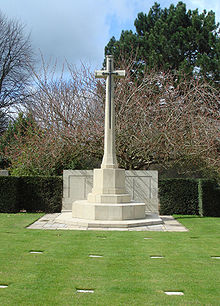
The Cross of Sacrifice (found in most CWGC cemeteries worldwide) and Screen wall of names at Birmingham Lodge Hill Cemetery. Image: Wikipedia
Born in Birmingham, Albert Wright worked at Birmingham Botanic Gardens as an Outdoor Foreman from April 1914 to February 1916, leaving Kew Gardens where he studied from May 1912 to April 1914 (being an Assistant 1st Class). His Kew Guild Journal obituary 1920/21 lists him as joining the 5th Warwickshire Regiment, moving with them to France in May 1917. In 1917 he was invalided home with fever before returning to France where he was wounded in the leg whilst wiring out in front of the trenches. Sent to hospitals in Glasgow, Irvine and finally Liverpool he died of influenza and pneumonia before discharge in hospital, three months after the war ended.
In the Kew Guild Journal 1920, p.482, the article on the War Memorial mentions that “Two additional names have to be added to the Tablet. Pte. Albert Wright and L.Cpl. Sidney Cockcroft.”
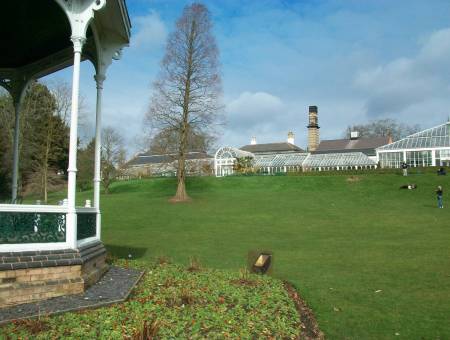
A view familiar to gardener Albert Wright, the view of Birmingham Botanic Gardens from the Bandstand where local MP Neville Chamberlain spoke to crowds after becoming Prime Minister shortly before WW2. Underneath ironically is the WW2 Air Raid shelter. Photo: Mark Norris, 2011
Priavte 201656 Albert Wright is listed on the CWGC website as finally serving in the 2/7th Royal Warwickshire Regiment. He was 29 when he died and the brief additional information says he was ‘Born at Birmingham’, around 1890.
Further photographs of the Lodge Hill cemetery graves can be seen on the Traces of War website. Albert Wright is also listed in the large central Hall of Memory which records the names of the 12,320 Birmingham citizens who died in the First World War (The Birmingham City Council website notes that a further 35,000 Birmingham men came home with a disability).
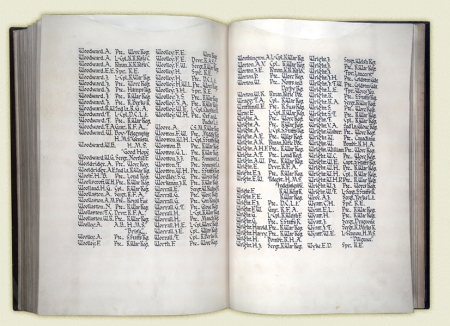
Albert Wright’s entry Royal Warwickshire Regiment, Hall of Memory WW1 book, Birmingham (Image: hallofmemory.co.uk)
Other Kew Casualaties
Several other non-Kew staff are listed in the early Kew Guild Journal roll of honour (but not as far as I know on the memorial) such as “employed as temporary labourers when the war broke out” who then joined up.
One such was T. Clay (Killed in action) noted by the Kew Guild Journal 1915/16 Journal publication. Of the 6 T. Clays on the CWGC website, he is likely to be one of two 1914/15 casualties likely to be remembered on the Le Touret Memorial – either Private Thomas Clay 9308, 3rd Battalion Worcestershire Regiment killed 28 October 1914 or Private Thomas Clay 10586 2nd Battalion, South Staffordshire Regiment killed on 18 May 1915.
A postwar Kew Guild Journal 1921, p.43 “In Memoriam” section records that the deaths “of W. Humphris and Mr J. Hayhurst of the Border Regiment … are recorded in the war but we have been unable to obtain any particulars”.
W. Humphris (unusual spelling) does not appear to have been otherwise listed on the Kew Gardens memorial and served with Australian forces. Private Walter George Thorrell Humphris 2632 served in 1st Battalion Australian Infantry AIF and died aged 25 on 22 April 1917. He has no known grave and his name is recorded on the Basra Memorial. He is listed as the son of James Thorrell Humphris and Jane Ellen Humphris, born London, England. He joined Kew in August 1903 from Oakwood Hall, Rotherham. He left Kew in August 1904 to work at Riverslea, Grassendale Park, Liverpool.
There is still far more to be discovered about each of these names. From Birtle’s posts on Rootschat, it appears that Kew Gardens archives have staff photographs of each year of new gardeners. I will add further details of my research into each casualty to the post as I uncover more.
There is a contact form if you wish to comment or pass on more information.
If any readers visit any of these Kew Gardeners’ graves, please lay a flower, a poppy cross or spend a few moments of prayer or quiet reflection on the shortened lives of these men and the families and colleagues they left behind them, so that they, like the lost gardeners of Heligan, are not forgotten.
If any of you visit the Helles Memorial in Turkey where Walter Henry Morland is remembered, the “rose specialist” who started me off on this quest to find out more about Kew’s lost gardeners, then perhaps the most appropriate flower to leave is of course … a rose.
Floreat Kew!
Tags: Birmingham Botanic Gardens, botanic gardens, C.F. Ball, Cobbold, commonwealth war graves commission, Kew Gardens, Kew Guild, Morland, Royal Botanic Gardens Edinburgh, war memorials, WW1
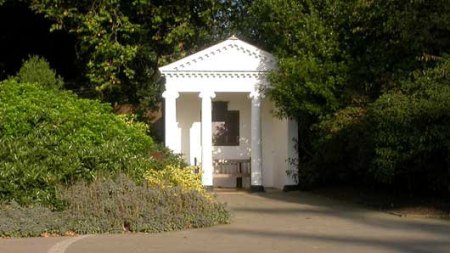
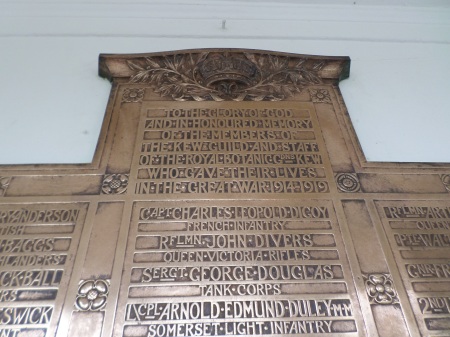
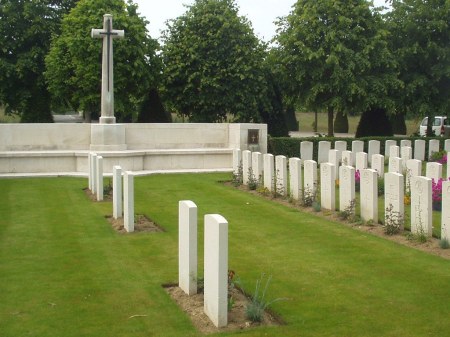
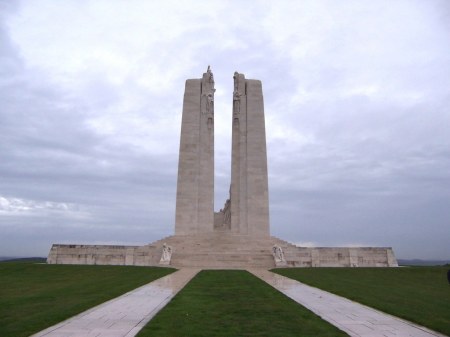
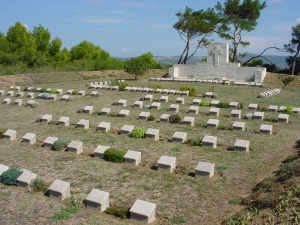
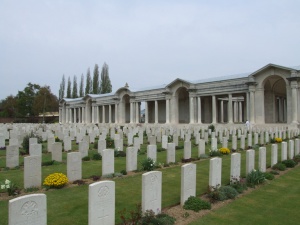
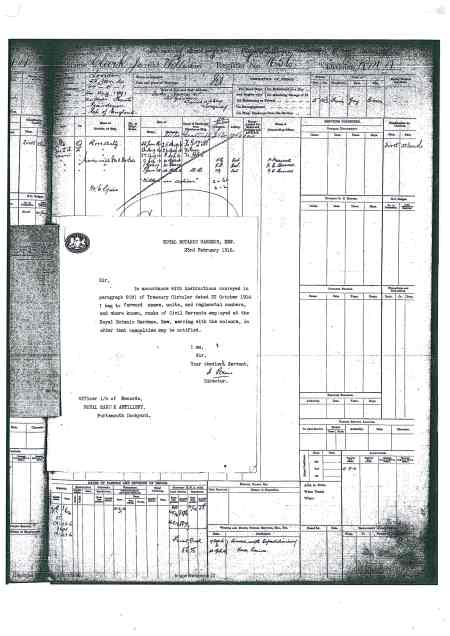
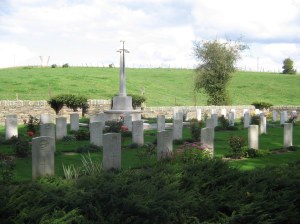
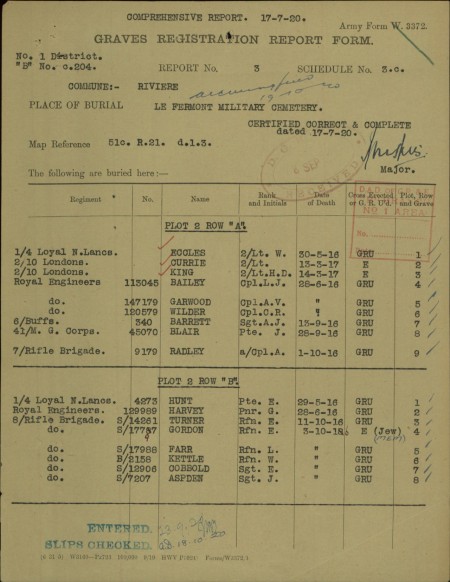
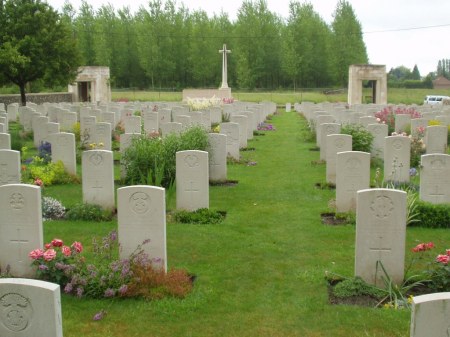
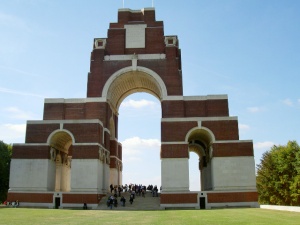
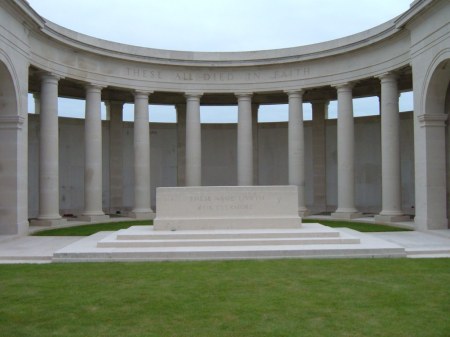
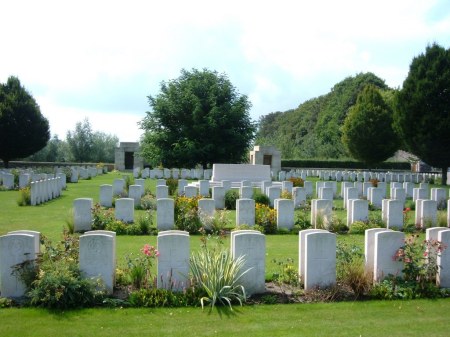
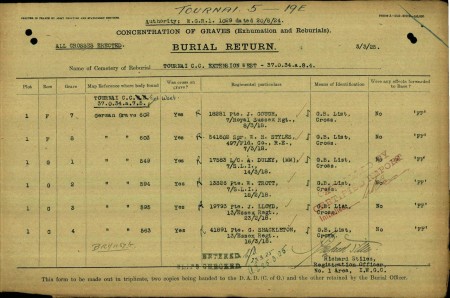
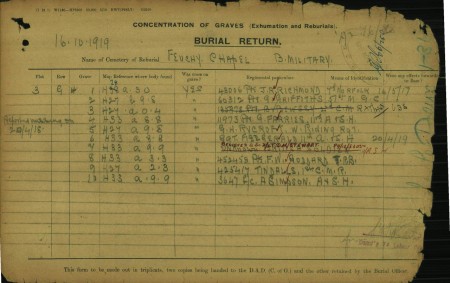
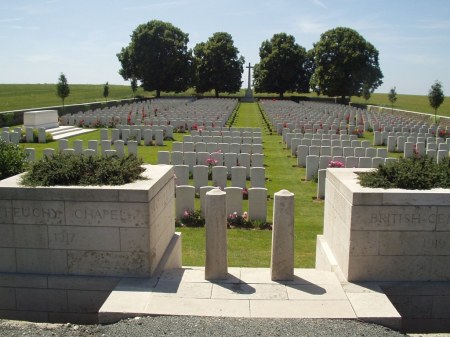
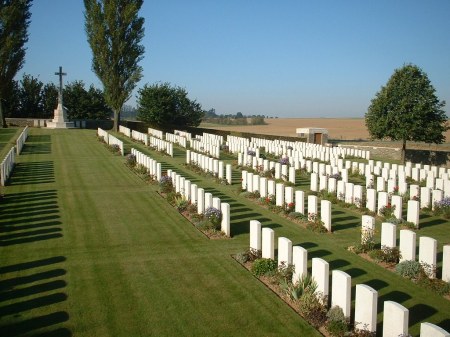
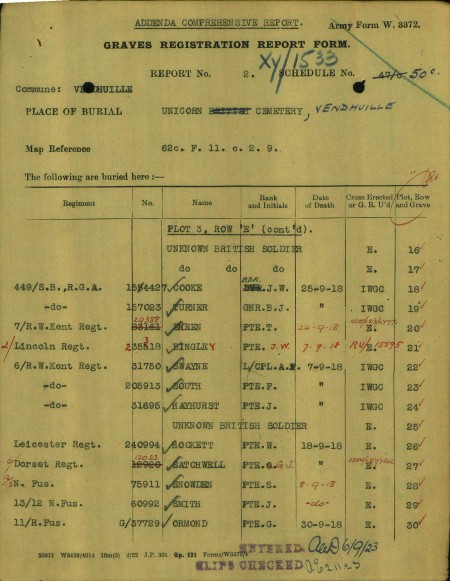
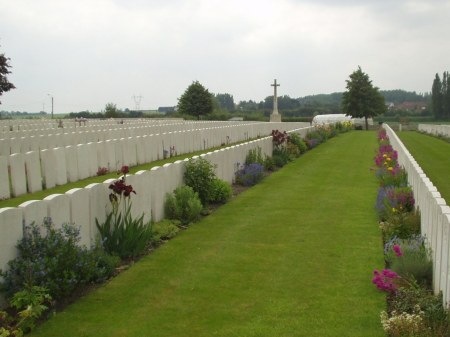
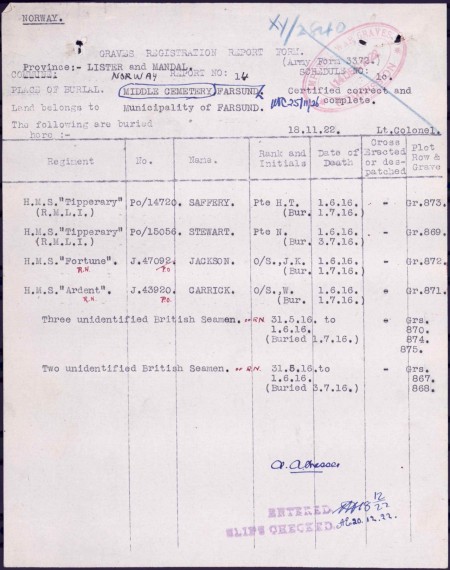
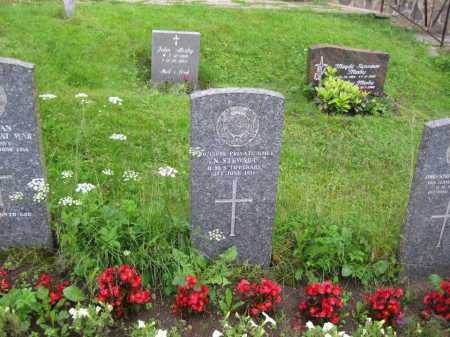
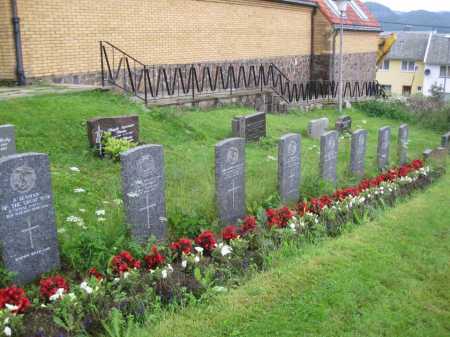
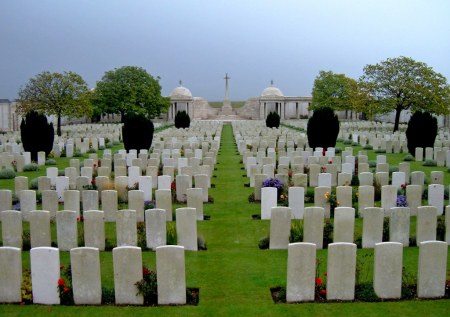
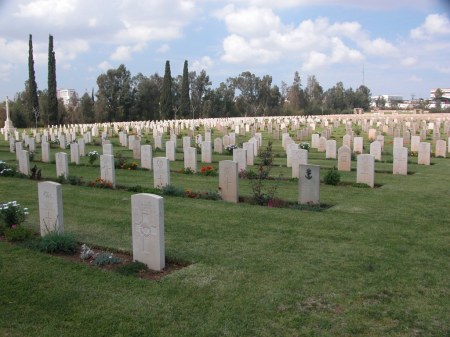

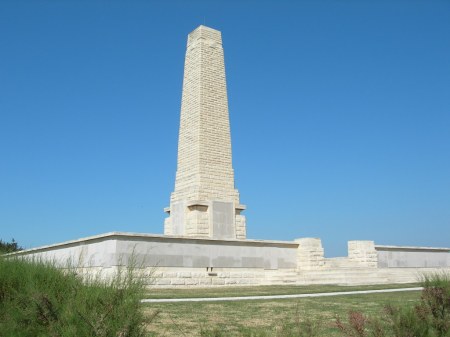
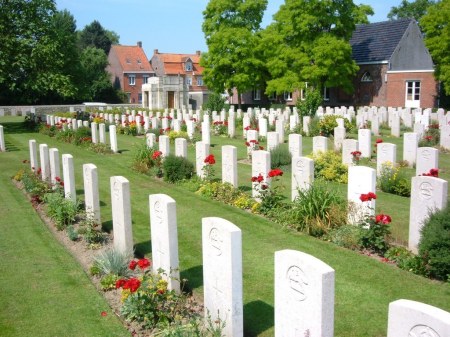
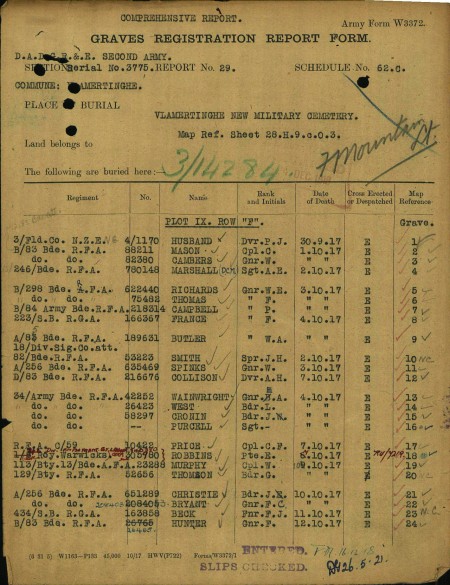
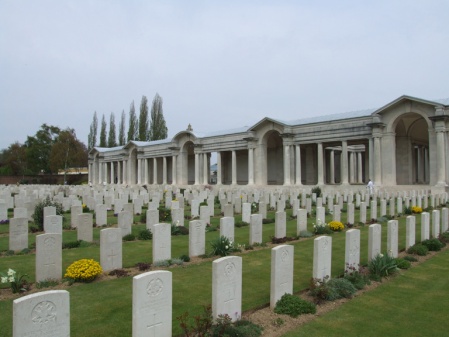
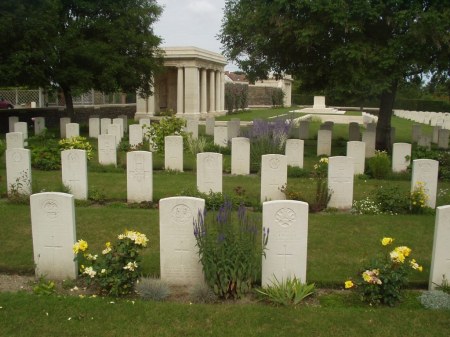
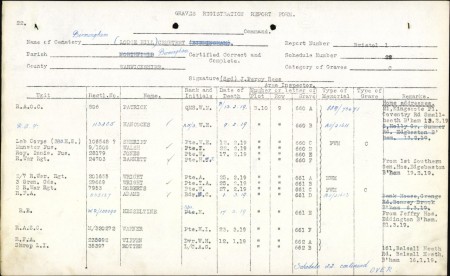
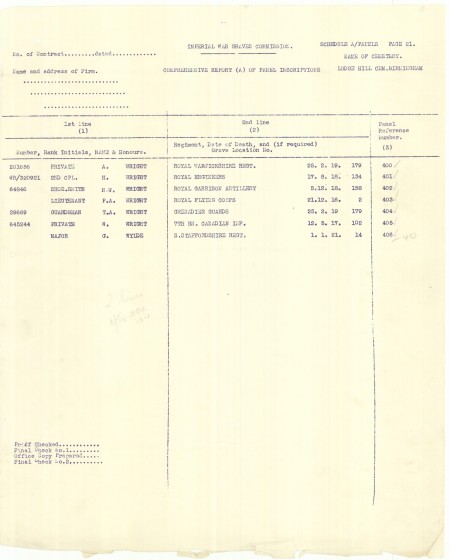
January 13, 2014 at 12:40 pm |
[…] Corporal Herbert Cowley returned from the trenches in 1915 to his editing desk at The Garden magazine, walking with a stick from a shrapnel wound to his knee cap. In this he was somewhat lucky as 37 of his former Kew Gardens colleagues were killed (see blog post on the Lost Gardeners of Kew WW1 ). […]
LikeLike
January 29, 2014 at 9:05 pm |
[…] looking at, ahead of the 1914 centenary. We’ve already blogposted about the war memorials at Kew Gardens and London Zoo – see previous […]
LikeLike
June 26, 2014 at 9:51 pm |
Thank you for this amazingly helpful blog. I am preparing an article (non-commercial) about Gardener’s in WW1 — this is inspiring. I will reference the blog but would like to include the author if you can let me have details.
LikeLike
June 29, 2014 at 8:26 am |
Dear Diana
Thanks for your comments – yes I ‘m very happy for you to reference the blog and its author (my name and title is Mark Norris, World war Zoo Gardens project, Newquay Zoo). Keep watching this space as I have another article on gardeners in WW1 due this week culled from the early 1914 1915 pages of garden journals (now online)
Worth having a look at what the Museum of Garden History, Heligan and various others are planning re gardeners of WW1, along with an exhibition at Kew Gardens – http://www.kew.org http://www.kew.org/visit-kew-gardens/whats-on/wartime-tour-gardens
http://www.kew.org/visit-kew-gardens/whats-on/first-world-war-tribute
I’m doing a talk open to the public there on 20 October 2014 keep watch on http://www.kew.org/kmis for the new 2014/5 programme
LikeLike
June 29, 2014 at 9:50 am |
Brilliant, I will send you a copy of the article. Thank you again
LikeLike
June 29, 2014 at 1:07 pm |
[…] J.L. Veitch of the famous Nursery family was swiftly gazetted a Captain in the 7th Cyclists’ Battalion, Devonshire Regiment and saw action in France by Christmas 1914. He was one of many Kew Gardens trained men to be killed later in the war on 21 May 1918, an obituary being posted in the Gardener’s Chronicle on 1 June 1918. Later in the same month in 1914, 40 Kew Gardens men were noted as volunteered (see our Kew WW1 blogpost). […]
LikeLike
July 30, 2014 at 1:06 pm |
[…] can also read more about Kew Gardens in WW1 and garden editor Herbert Cowley’s wartime career on our past blog […]
LikeLike
August 3, 2014 at 10:42 am |
[…] https://worldwarzoogardener1939.wordpress.com/2013/07/19/such-is-the-price-of-empire-the-lost-gardene… […]
LikeLike
April 25, 2015 at 5:39 am |
[…] Ball and Morland’s stories are told more fully on the Kew Gardens WW1 War Memorial blogpost: https://worldwarzoogardener1939.wordpress.com/2013/07/19/such-is-the-price-of-empire-the-lost-garden… […]
LikeLike
May 7, 2015 at 3:10 pm |
[…] RBGE commemorates WW1 Lost gardeners of Kew […]
LikeLike
July 14, 2015 at 8:22 am |
[…] Old Kewites returned from working in many parts of the Empire to serve in the armed forces in both world wars. You can read more about Campbell and the other Kew Gardens staff casualties at our previous Kew WW1 blogpost “Such is the Price of Empire.” https://worldwarzoogardener1939.wordpress.com/2013/07/19/such-is-the-price-of-empire-the-lost-garden… […]
LikeLike
September 26, 2015 at 7:46 am |
[…] https://worldwarzoogardener1939.wordpress.com/2013/07/19/such-is-the-price-of-empire-the-lost-garden… […]
LikeLike
October 10, 2015 at 9:03 am |
[…] https://worldwarzoogardener1939.wordpress.com/2013/07/19/such-is-the-price-of-empire-the-lost-garden… […]
LikeLike
November 5, 2015 at 9:15 am |
[…] https://worldwarzoogardener1939.wordpress.com/2013/07/19/such-is-the-price-of-empire-the-lost-garden… […]
LikeLike
March 16, 2016 at 12:30 pm |
[…] https://worldwarzoogardener1939.wordpress.com/2013/07/19/such-is-the-price-of-empire-the-lost-garden… […]
LikeLike
May 22, 2016 at 9:03 pm |
[…] https://worldwarzoogardener1939.wordpress.com/2013/07/19/such-is-the-price-of-empire-the-lost-garden… […]
LikeLike
May 26, 2016 at 6:23 pm |
Charles Henry Anderson was a fool and a show-off, who got himsel killed through his own stupidity-and cost the life of another man, as well as 5 others wounded. He was in an army hut behind the line, kitted up for a trench raid and each man had been issued with 2 No.5 Mills Bombs- all except Anderson carried them in their gas satchels. He was showing off- how he had cut slits in the inside lining of his leather jerkin,so get bombs out more quickly. He was demonstrating this when the pin came out of one of the grenades-he ran to the door but the bomb exploded-the Court of Enquiry concluded that the bomb was not a faulty short fuse but recommedned that improvements be made to the actual pin. The Corps Commander, Lt-Gen Sir Richard Haking recommedned hin for the Albert Medal- By modern standards, an absolutely bizarre decision. Court of Enquiry report is in the service file for the other man killed- Bertram Fussell, which can be found on Ancestry. Anderson and Fussell are buried side by side.
LikeLike
June 7, 2016 at 8:40 am |
Dear Mike Thompson
Thanks for the information or alternative interpretation which I will weave into Anderson’s part of the Kew Blog. As you mention the Albert Medal recommendation appears today “an absolutely bizarre decision”; maybe some wartime attempt to hide the awkwardness or embarrassment to his family and regiment and maintain morale and good press for the war effort. I shall check with My Kew Colleague James Wearn and also look up Fussell’s Court of Enquiry Report. I shall mark the centenary of Anderson and Fussell’s deaths on the blog on 29/30 November 1916/2016 Apologies for the delay in replying. Many thanks for reading, researching and commenting, it makes the blog very worthwhile as an evening slog sometimes! Many thanks, Mark Norris, World War Zoo Gardens Project
LikeLike
May 31, 2016 at 8:04 am |
[…] The story of the Kew Gardeners remembered on their staff war memorial in WW1 is told here: https://worldwarzoogardener1939.wordpress.com/2013/07/19/such-is-the-price-of-empire-the-lost-garden… […]
LikeLike
July 1, 2016 at 6:33 am |
[…] https://worldwarzoogardener1939.wordpress.com/2013/07/19/such-is-the-price-of-empire-the-lost-garden… […]
LikeLike
July 18, 2016 at 8:01 am |
[…] https://worldwarzoogardener1939.wordpress.com/2013/07/19/such-is-the-price-of-empire-the-lost-garden… […]
LikeLike
August 10, 2016 at 1:10 pm |
[…] , especially for me having been involved with Kew Gardens wartime stories and also researched their staff war memorial stories. Audrey Le Lievre as a garden writer is a new name to me but wrote Miss Willmott of Warley Place: […]
LikeLike
December 11, 2019 at 9:47 am |
[…] https://worldwarzoogardener1939.wordpress.com/2013/07/19/such-is-the-price-of-empire-the-lost-garden… […]
LikeLiked by 1 person
June 7, 2020 at 7:23 am |
Excellent price of research – thoroughly enjoyed it, having visited the Kew memorial several times
LikeLike
June 22, 2020 at 9:31 am |
Thank you, it was a pleasure to work with some of the Kew staff like James Wearn on this during the WW1 Centenary, be invited to a CWGC / Kew function and do a Kew Guild talk there, just as some of these fallen men on the war memorial had done during their training.
LikeLike